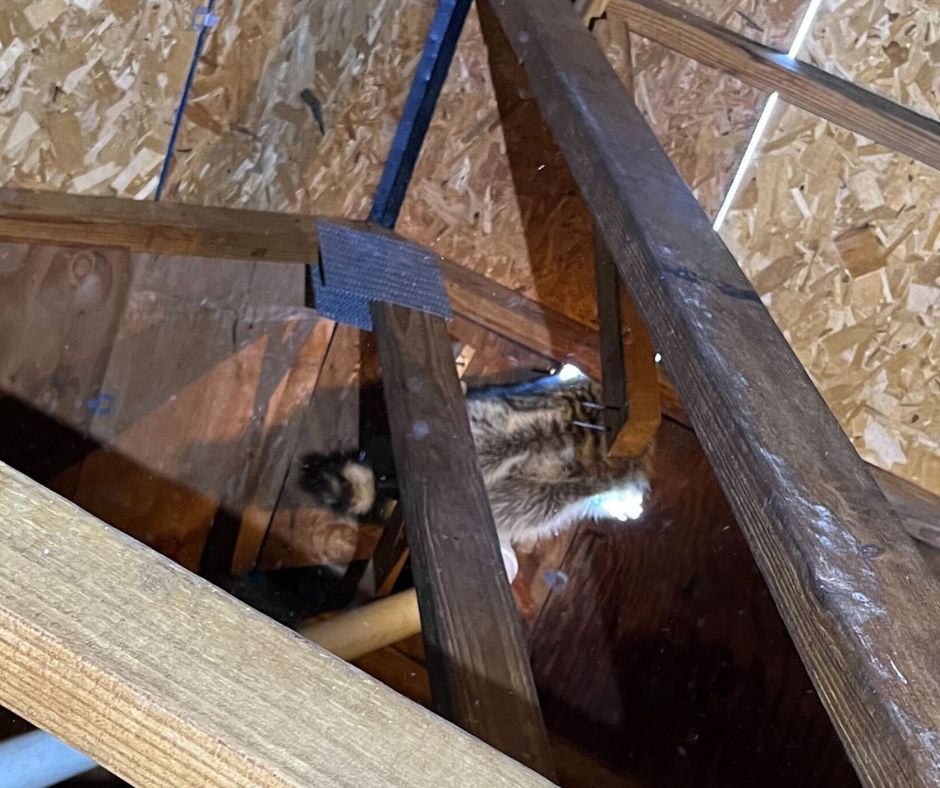 Do Raccoons Hibernate? Understanding Their Winter Behavior and How They Survive the Cold
Do Raccoons Hibernate? Understanding Their Winter Behavior and How They Survive the Cold
Do Raccoons Hibernate? Understanding Their Winter Behavior and How They Survive the Cold
Raccoons do not fully hibernate like bears and groundhogs do. If faced with severe temperatures and a lack of food, raccoons can enter a state of torpor, or decreased activity, to conserve their energy. Raccoons will only enter torpor when necessary, and they prefer to seek out warm shelter and abundant sources of food to survive the winter. Unfortunately, this often means that they will break their way into your attic in order to build nests inside, often ripping up your attic insulation and tearing through any ductwork inside the attic in the process. If you need raccoon trapping and removal in Westchester County, Putnam County, Dutchess County, Fairfield County, or Litchfield County, contact the wildlife removal experts at Westchester Wildlife today at (800) 273-6673 for a FREE estimate!
How Raccoons Survive the Cold
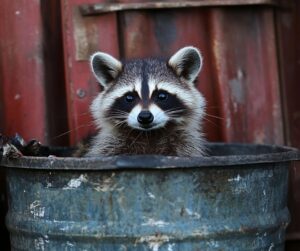 Raccoons do not hibernate during the winter, so they have several other body processes to help them survive the freezing temperatures and harsh conditions of winter. Raccoons, when faced with no other options, will enter a state of lowered activity called torpor, which is distinctly different from hibernation.
Raccoons do not hibernate during the winter, so they have several other body processes to help them survive the freezing temperatures and harsh conditions of winter. Raccoons, when faced with no other options, will enter a state of lowered activity called torpor, which is distinctly different from hibernation.
Torpor is involuntary and happens when faced with environmental challenges, while hibernation is a process that animals prepare for. Additionally, torpor doesn’t last for a long time, typically only a few hours to a few days, and raccoons will wake up to forage during this time. Hibernation on the other hand, lasts for months, and animals in hibernation do not wake up to forage. Raccoons often rely on stored body fat to survive the winter, and may engage in less activity in order to conserve their energy. Raccoons also have a thick, grey coat of fur that provides them with insulation against freezing temperatures and snow. However, raccoons still need to find sources of shelter during the winter, which might lead them to your home.
Where Raccoons Seek Shelter in Winter
During the winter months, raccoons will seek shelter to escape the freezing temperatures and precipitation. Sometimes this can be a natural shelter, like the inside of a hollow tree or log. Raccoons will also seek shelter inside rock crevices, and they will oftentimes take over burrows that were originally dug out by groundhogs, skunks and foxes but have since been abandoned. However, nowhere is more perfect for a raccoon den than your home.
What Drives Raccoons Indoors During the Winter
During the winter, food sources are much more scarce for raccoons. Plants are dead and insects are underground, so the pickings are slim for a hungry raccoon. This often drives them into urban and suburban neighborhoods, as our homes and businesses provide them with plenty of food. Unsealed trash cans, full of food scraps, provide a perfect food source for a hungry raccoon, as do compost piles. If you leave pet food outside, this provides an easy meal for a raccoon, as do bird feeders.
Raccoons will build their nests underneath your deck/porch, inside a shed or crawl space, or especially inside your attic, for the warmth, safety, and seclusion these places provide. Your attic provides a perfect nesting spot for a raccoon seeking to escape the cold, as it offers protection against predators and the elements. However, raccoons aren’t a house guest you want to willingly shelter, as these mischievous critters can tear through HVAC ducts, destroy your attic insulation, and spread harmful diseases and bacteria.
Signs of a Winter Raccoon Infestation
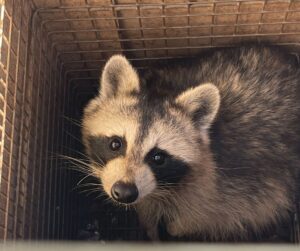 Raccoons are one of the most destructive nuisance wildlife in the Westchester area. Raccoons will exploit the tiniest cracks in your soffit, gable vents, ridge vents, or roof shingles. When a raccoon is nesting inside your attic, you might see damaged soffits, bent or destroyed vents, and missing shingles, signifying where the raccoons are entering and exiting from. Once inside, these critters will start ripping up and shredding your attic insulation, tearing through HVAC ducts, and scratching/gnawing on wooden beams and wires. Raccoons are mostly active at night, so if you are hearing scratching or loud shuffling sounds coming from your attic space, this is a sign that you have raccoons spending the winter in your home.
Raccoons are one of the most destructive nuisance wildlife in the Westchester area. Raccoons will exploit the tiniest cracks in your soffit, gable vents, ridge vents, or roof shingles. When a raccoon is nesting inside your attic, you might see damaged soffits, bent or destroyed vents, and missing shingles, signifying where the raccoons are entering and exiting from. Once inside, these critters will start ripping up and shredding your attic insulation, tearing through HVAC ducts, and scratching/gnawing on wooden beams and wires. Raccoons are mostly active at night, so if you are hearing scratching or loud shuffling sounds coming from your attic space, this is a sign that you have raccoons spending the winter in your home.
Raccoons dig latrines inside your attic insulation to deposit their waste, so a foul smell coming from the attic can signify a problem. This can get even worse if the waste accumulates in such large quantities that it begins to seep through the floor.
If you come outside and see your trash cans knocked over with trash strewn about your yard, or pet food missing from your dog’s bowl despite him being inside all night, you might have a raccoon feasting on your food scraps. It’s important to deal with a raccoon invasion as soon as possible, as these nuisance animals can spread harmful diseases, bacteria, and parasites, like rabies, raccoon roundworm, tularemia, leptospirosis, and more.
How To Prevent Raccoons from Invading Your Home This Winter
There are several easy ways to prevent raccoons from setting up shop in your home this winter:
- Secure all trash cans with a tightly-fitting lid, and remove all outdoor food sources
- Trim tree branches near your home to reduce easy access to the roof for raccoons.
- Contact a licensed wildlife removal company like Westchester Wildlife to locate, seal and fortify all potential entry points on your roof
- Contact Westchester Wildlife to install chimney caps and roof vent guards to keep raccoons out
How Do I Get Rid of Mice in Westchester?
Mice are drawn to food, clutter, water leaks and insulation inside the home, and they can contaminate your food supply, create fire hazards with their gnawing habits and lower the effectiveness of your insulation. Westchester Wildlife can help. We offer effective mice control solutions in Westchester County, NY as well as Putnam County, Dutchess County, and Fairfield County, CT. We will use a combination of mice control techniques including snap traps, bait stations, and exclusion work to eliminate your current mice problem and keep any more from popping up. Contact us today at 800-273-6673!
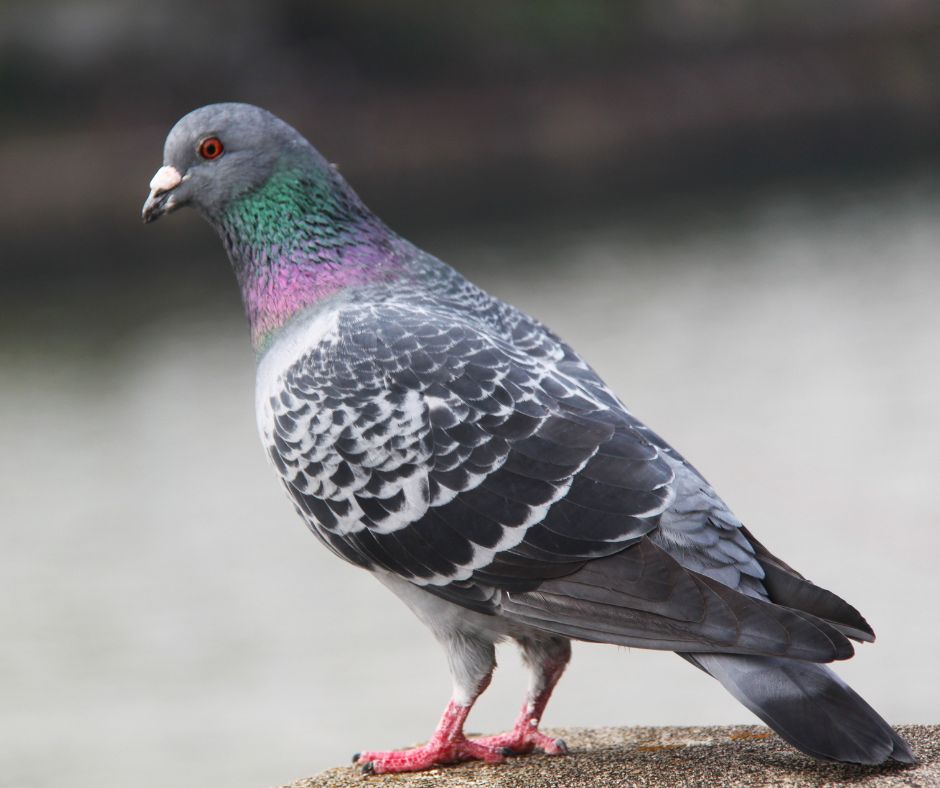 How To Deal With Pigeon Problems in the Winter
How To Deal With Pigeon Problems in the Winter
How To Deal With Pigeon Problems in the Winter
When the freezing temperatures of winter arrive in the Westchester County area, wildlife like groundhogs and snakes will become less active, going into hibernation or torpor to survive the winter. However, several other species of nuisance wildlife are well-adapted to the cold, and will continue searching for sources of food and places to shelter through the winter months. Pigeons are especially well-adapted to surviving the winter, and these nuisance birds, most having lost a natural fear of humans, have no problem seeking food and shelter inside buildings. When pigeons nest inside your property, they can create unsanitary messes, spread parasites, and even damage structures with their acidic droppings. Don’t worry, Westchester Wildlife can help. Our team offers safe, humane pigeon deterrent and removal services in the Westchester, NY area. Contact our team to get started today with a FREE estimate at (800) 273-6673!
Do Pigeons Migrate For The Winter?
When you think of birds in the winter, you might picture a flock of geese flying south in a “v” formation to wait out the colder temperatures. While plenty of birds in New York like sparrows, thrushes and ducks migrate south, the crafty pigeon is more than well-equipped to survive New York’s wintry weather. Pigeons have a thick, downy coat of fluffy feathers that can allow them to survive in temperatures as low as -40 degrees fahrenheit! Pigeons are also well-adapted to eating bread crumbs and other human food that we leave outside year-round, so they don’t face a shortage of food in the winter. Pigeons tend to not have the usual fear of humans that other birds do, so they might become even more bold in the winter, getting closer to our homes and businesses as they search for food scraps and warm places to build their nests.
Pigeon in Attic Damage
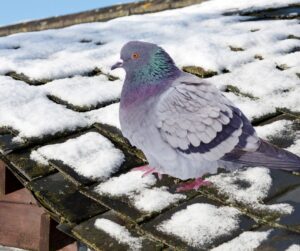 During the winter, pigeons that are well-adapted to urban and suburban areas will be searching for safe, warm places to begin building their nests. Unfortunately, your home’s attic provides the perfect harborage for these avian pests. Pigeons will nest inside your attic, your dryer vents, your gutters, and any other little pocket they can find in your home. Pigeon nests can be dangerous, as the dry twigs, dead leaves, dead grass and straw can lead to a fire hazard, especially if they are nesting inside your dryer vent. If their nests are inside your attic space, these birds can damage your shingles and your siding as they enter and exit the attic. Pigeons might also rip out your attic insulation to add to their nests, which can decrease the insulation’s ability to resist heat. However, the most significant damage caused by pigeons nesting in your home is through their corrosive droppings. Pigeon droppings are known to contain acidic uric acid, which can eat away at materials like wood, metal, shingles, and paint. Not only can this corrode the structures in your home, it can also lead to unsightly staining.
During the winter, pigeons that are well-adapted to urban and suburban areas will be searching for safe, warm places to begin building their nests. Unfortunately, your home’s attic provides the perfect harborage for these avian pests. Pigeons will nest inside your attic, your dryer vents, your gutters, and any other little pocket they can find in your home. Pigeon nests can be dangerous, as the dry twigs, dead leaves, dead grass and straw can lead to a fire hazard, especially if they are nesting inside your dryer vent. If their nests are inside your attic space, these birds can damage your shingles and your siding as they enter and exit the attic. Pigeons might also rip out your attic insulation to add to their nests, which can decrease the insulation’s ability to resist heat. However, the most significant damage caused by pigeons nesting in your home is through their corrosive droppings. Pigeon droppings are known to contain acidic uric acid, which can eat away at materials like wood, metal, shingles, and paint. Not only can this corrode the structures in your home, it can also lead to unsightly staining.
Diseases Spread by Pigeons
Pigeon droppings often contain the spores that cause the fungal lung infection histoplasmosis. When you move or disturb pigeon droppings, the spores get kicked up into the air, and can infect you when you breathe these spores in. Additionally, pigeon droppings can also spread other illnesses like the bacterial disease psittacosis, the fungal disease cryptococcosis, and foodborne illnesses like E. coli and salmonella. Additionally, pigeons can carry bat bugs, a small insect pest that are very similar to bed bugs. Pigeons can also spread bird mites into your home. Pigeons pose a significant health hazard, and the more pigeons that are roosting in your home, the more significant the health threat is. It’s important to protect yourself by having nuisance pigeons removed or deterred as soon as possible.
Humane Pigeon Removal Services
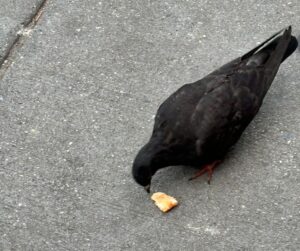 Pigeons can pose a risk to your home through their flammable nests and their corrosive droppings, and they can also pose a health hazard to you and your family through the various diseases and parasites they carry and spread. If you are hearing pigeon coos and flapping noises coming from your attic, or if you are seeing pigeon droppings and feathers around your property, it’s best to contact a licensed wildlife removal professional like Westchester Wildlife for pigeon removal services immediately. Our team of wildlife experts will carefully inspect your home for signs of pigeons, locating all the entry points and nesting. We will safely and humanely trap and remove all the pigeons on your property, and remediate any damage caused by these pest birds. Additionally, we also offer dead bird removal if you have a dead pigeon inside your home or yard. If you need pigeon removal services in the Westchester area, contact our team today to get on the schedule at (800) 273-6673.
Pigeons can pose a risk to your home through their flammable nests and their corrosive droppings, and they can also pose a health hazard to you and your family through the various diseases and parasites they carry and spread. If you are hearing pigeon coos and flapping noises coming from your attic, or if you are seeing pigeon droppings and feathers around your property, it’s best to contact a licensed wildlife removal professional like Westchester Wildlife for pigeon removal services immediately. Our team of wildlife experts will carefully inspect your home for signs of pigeons, locating all the entry points and nesting. We will safely and humanely trap and remove all the pigeons on your property, and remediate any damage caused by these pest birds. Additionally, we also offer dead bird removal if you have a dead pigeon inside your home or yard. If you need pigeon removal services in the Westchester area, contact our team today to get on the schedule at (800) 273-6673.
Pigeon Deterrents
In addition to pigeon removal services, pigeon deterrents are also effective at keeping these pesky birds away from your property. Bird spikes can be placed around target areas like roofs to keep pigeons from landing on your home, and bird netting can prevent them from getting inside your yard. Getting rid of bird feeders and bird baths can help deter pigeons, and so can ensuring that you have a tight, sealed lid on your trash cans. Westchester Wildlife offers bird exclusion services to keep pigeons out of your attic. We will locate all potential entry points for pigeons, and then seal them off and fortify them, preventing pigeons, other birds, and even other wildlife like raccoons and squirrels from getting in.
Best Pigeon Removal in Westchester, NY
Pigeons may just seem like a nuisance you see begging for bread crumbs, but when a group of pigeons decides to settle down on your property, they can become a serious problem. Pigeon droppings can corrode wood and metal, as well as spread harmful diseases like histoplasmosis. Pigeons themselves can carry parasites like bat bugs and bird mites, and they can rip up your insulation to add to their nests, which are often made out of flammable materials like straw and dead leaves. Don’t worry, Westchester Wildlife can help. Our team of wildlife experts can safely and humanely remove and exclude pigeons from your property in Westchester County. Contact our team to get started today with a FREE estimate at (800) 273-6673.
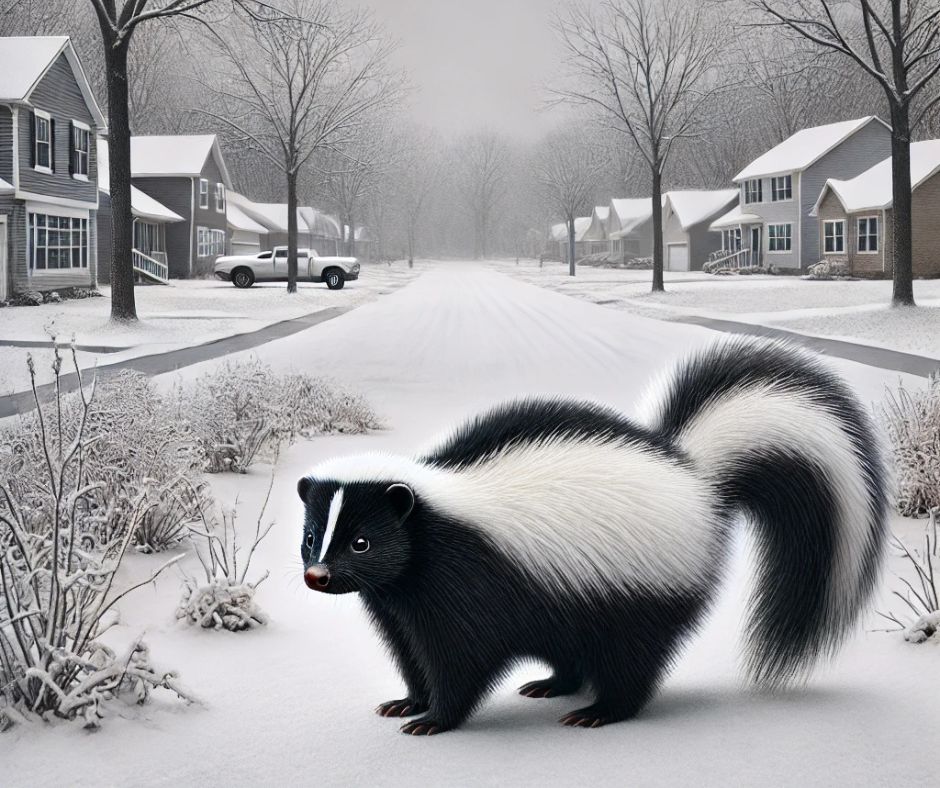 Where Do Wildlife Go In The Winter?
Where Do Wildlife Go In The Winter?
Where Do Wildlife Go In The Winter?
You might associate the presence of nuisance wildlife like squirrels, raccoons and skunks with the hot temperatures and longer days of summer, but where do they go during the colder, snowy months? While some critters like snakes and groundhogs go into torpor and hibernation, squirrels, raccoons, rodents and skunks will stay active throughout the winter, trying to get inside your attic or crawl space, or ripping up your yard in search of food. If you are dealing with nuisance wildlife causing problems on your property in Westchester, then contact the experts at Westchester Wildlife. We offer safe, humane, wildlife trapping and removal services in the Westchester, Dutchess, and Putnam County areas.
Squirrels
 Squirrels stay active throughout the entire fall, scavenging for nuts and seeds they can store inside piles of food called “caches” that they hide around their territory. Squirrels can hide their food inside hollow tree cavities, inside holes in the ground, or sometimes even inside attic spaces or wall voids. During the winter, squirrels will begin retrieving food from their caches, while also searching for warm, safe places to spend the winter. Unfortunately, this often means squirrels will set up shop in your attic. Squirrels inside the attic will rip up your insulation to make their nests, often soiling it in the process with urine and droppings.
Squirrels stay active throughout the entire fall, scavenging for nuts and seeds they can store inside piles of food called “caches” that they hide around their territory. Squirrels can hide their food inside hollow tree cavities, inside holes in the ground, or sometimes even inside attic spaces or wall voids. During the winter, squirrels will begin retrieving food from their caches, while also searching for warm, safe places to spend the winter. Unfortunately, this often means squirrels will set up shop in your attic. Squirrels inside the attic will rip up your insulation to make their nests, often soiling it in the process with urine and droppings.
Raccoons
Similar to squirrels, raccoons will gorge themselves on food during autumn, building up fat reserves to protect them during the winter. However, raccoons do not build up food caches and instead must continue searching for food throughout the winter. This won’t be too hard for the crafty raccoon, as these scavengers eat pretty much anything. Raccoons will become more desperate for food during the winter, and more willing to invade your property to dig through your trash can, raid your bird feeder, or eat out of pet food bowls that have been left outside. Raccoons do not hibernate, but they may den together to conserve body heat and enter a state of lowered activity called torpor when the temperatures go below 20 degrees. Raccoons will also seek out shelter within your home, getting inside your attic where they will tear through insulation and HVAC ducts. Raccoons also dig latrines inside insulation, where the waste can build up in such large quantities that it can begin to seep through the ceiling.
Mice and Rats
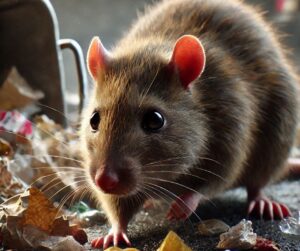 Mice and rats have evolved to live alongside humans, and the warmth and food associated with our homes often draws these rodents inside when the temperatures drop. Mice might huddle in their outdoor nests and slow down their activity when the weather begins to get really frigid. Rats cannot survive without people, and will die in the winter if they can’t find shelter or food. Rodent activity will ramp up as the temperatures plummet. You might see greasy marks alongside the baseboards of your home that are left by rats brushing their fur up against it. Rats and mice need to gnaw to keep the length of their ever-growing teeth down, so they will chew holes in cabinet doors, wooden support beams, and the rubber covering around wires, which can expose the bare wiring and pose a fire risk. Mice will also tunnel through your insulation, which can affect its ability to resist heat. One of the main reasons why rodents are attracted to your home in the winter is because your home is often full of food. Whether it be spills and crumbs in the kitchen or dry, prepackaged food in the pantry, your home provides a banquet for hungry rodents in the winter. You might spot chewed holes in paper, soft plastic, or cardboard food packaging. Cleaning up all spills and crumbs immediately and keeping your prepackaged food in sturdy, hard plastic containers can help keep rodents out of your food supply.
Mice and rats have evolved to live alongside humans, and the warmth and food associated with our homes often draws these rodents inside when the temperatures drop. Mice might huddle in their outdoor nests and slow down their activity when the weather begins to get really frigid. Rats cannot survive without people, and will die in the winter if they can’t find shelter or food. Rodent activity will ramp up as the temperatures plummet. You might see greasy marks alongside the baseboards of your home that are left by rats brushing their fur up against it. Rats and mice need to gnaw to keep the length of their ever-growing teeth down, so they will chew holes in cabinet doors, wooden support beams, and the rubber covering around wires, which can expose the bare wiring and pose a fire risk. Mice will also tunnel through your insulation, which can affect its ability to resist heat. One of the main reasons why rodents are attracted to your home in the winter is because your home is often full of food. Whether it be spills and crumbs in the kitchen or dry, prepackaged food in the pantry, your home provides a banquet for hungry rodents in the winter. You might spot chewed holes in paper, soft plastic, or cardboard food packaging. Cleaning up all spills and crumbs immediately and keeping your prepackaged food in sturdy, hard plastic containers can help keep rodents out of your food supply.
Snakes
Snakes are cold-blooded and are less adapted to staying active during the winter. Snakes often brumate, or enter a period of lowered activity, during the winter. Snakes often brumate together in burrows, groundhog tunnels, fox holes, leaf litter, or even inside tree stumps or dead logs. While snakes generally stay away from homes during winter, they might set up shop inside your crawl space, especially if you have a steady population of mice and rats for them to eat.
Groundhogs and Skunks
Groundhogs actually DO hibernate, staying asleep in their underground tunnels from October to late February. When hibernating, a groundhog’s heartbeat slows to 4-10 beats per minute, and their breathing rate slows to one breath every six months. Groundhogs won’t be digging up your yard during the winter, but you might have to deal with another digging critter.
Skunks are scavengers that continue searching for food throughout the winter. During winter, as food sources become more scarce, skunks will be drawn to your property, searching for food within your trash cans. Skunks will also rip up your lawn to find beetle larvae known as grubs to eat. If your property provides enough food sources, skunks might dig out dens underneath your deck or porch, which can increase the likelihood of a spraying incident, especially because skunks spray to mark their territory.
Wildlife Trapping and Removal Near Me
If you are dealing with raccoons, squirrels, mice, rats, snakes, groundhogs or skunks on your property in Westchester County, contact the experts at Westchester Wildlife. Our team can protect your home from these pests and nuisance wildlife this winter. Once these critters have been removed from your property, we can provide you with exclusions and seal-outs to prevent them from returning. Contact our team to get started today with a FREE estimate at (914) 760-5713!
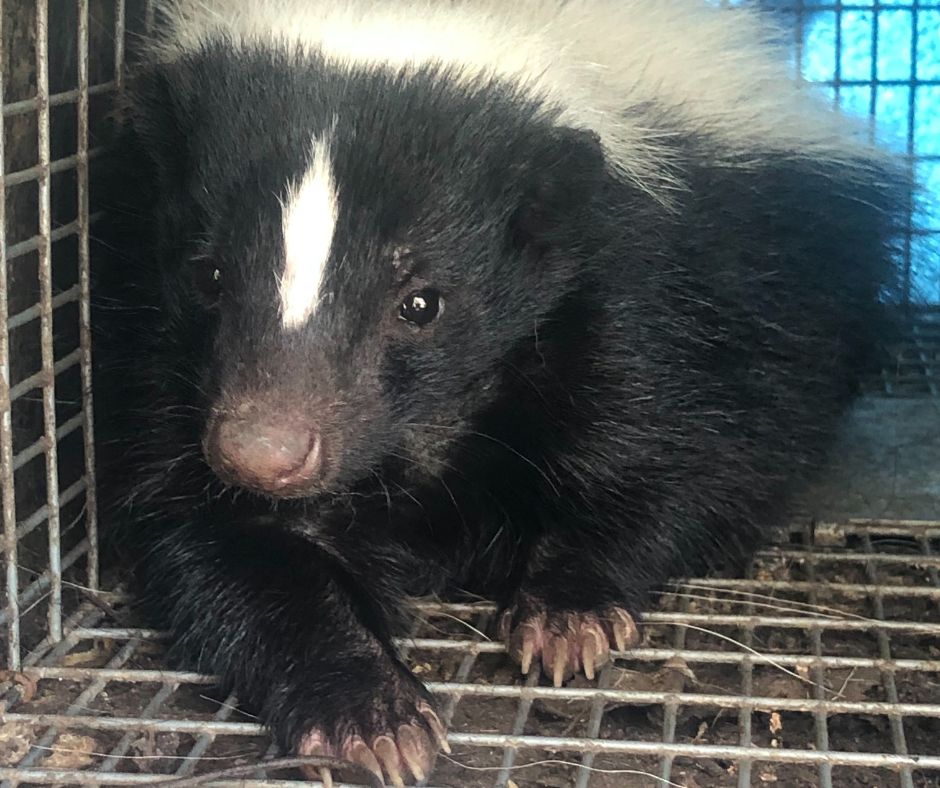 Dangers of a Skunk Problem
Dangers of a Skunk Problem
Dangers of a Skunk Problem
Skunks are the small striped black and white critters that are known for the extremely foul-smelling spray that they will douse threats and potential predators in. The smell of skunk sprays is very difficult to get rid of, especially if a skunk sprays your curious dog. However, this isn’t the only damage that skunks can do. Skunks will also knock over trash cans and raid left out pet food bowls, and they are also known to rip up your grass to find grubs to eat. Skunks will also dig out dens underneath sheds, porches, decks, and inside crawl spaces, spraying around these areas to mark their territory. Don’t worry, Westchester Wildlife can help. In addition to humane skunk trapping and removal services, we also offer wildlife barriers and exclusions to keep these critters off your Westchester property in the future.
Skunk Feeding Habits
Skunks are omnivorous scavengers, eating whatever edible thing they come across. Skunks will prey on mice, birds, bird eggs, voles, moles, and insects like grasshoppers, wasps, bees, crickets, beetles, and especially beetle larvae, also known as grubs. Because grubs are found deep within soil, skunks will rip up your lawn to find these easy meals. Skunks can also feed on your garden crops and any fruits, nuts, or seeds growing in your garden. Skunks are also excellent scavengers, and will happily knock over garbage cans for food, or raid your pet food bowls. Never feed skunks intentionally, as this will make the skunks lose their natural fear of humans, which can result in large congregations of skunks on your property, waiting for the next free meal.
Skunk Sprays
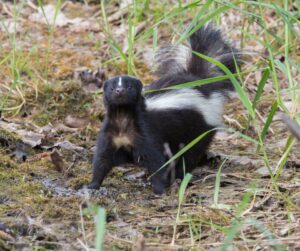 The biggest risk associated with skunks is the extremely foul-smelling spray they will unleash on whatever is posing a direct threat to them. Thankfully, skunks are not an aggressive animal, and will prefer to run away from a fight. Even if a skunk does spray, it gives plenty of warning signs. Skunks about to spray will adopt a wide stance, raise their tail in the air, and aggressively stomp their feet, so if you see a skunk displaying these behaviors, remove yourself from the situation immediately. Skunk sprays can be a major irritant, affecting the eyes, nose, and respiratory system. The odor is unbearable and can cause nausea, and it is very difficult to get rid of. It’s even more difficult to get rid of when the skunk sprays your dog, as the scent can get trapped in their fur.
The biggest risk associated with skunks is the extremely foul-smelling spray they will unleash on whatever is posing a direct threat to them. Thankfully, skunks are not an aggressive animal, and will prefer to run away from a fight. Even if a skunk does spray, it gives plenty of warning signs. Skunks about to spray will adopt a wide stance, raise their tail in the air, and aggressively stomp their feet, so if you see a skunk displaying these behaviors, remove yourself from the situation immediately. Skunk sprays can be a major irritant, affecting the eyes, nose, and respiratory system. The odor is unbearable and can cause nausea, and it is very difficult to get rid of. It’s even more difficult to get rid of when the skunk sprays your dog, as the scent can get trapped in their fur.
Skunk Dens
Skunks don’t nest inside attic spaces like raccoons or squirrels, instead they prefer to dig out dens for themselves and their young closer to the ground. Skunks will nest inside crawl spaces and underneath decks, porches, or sheds. Skunks also love rock piles or woodpiles, as they provide ideal cover. Skunks will spend lots of time in their dens during periods of harsh weather, or after they use their spraying defense, as it can take over a week for their scent gland to replenish itself. Skunks will also spray to mark their territory, and if they are spraying inside your crawl space or underneath your deck, the smell can rise up into your home.
Skunk Trapping and Removal
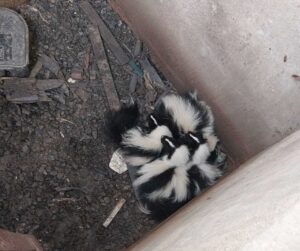 Never attempt to trap or remove skunks by yourself, as they can and will spray if they feel cornered, and they are also armed with sharp teeth and claws that they can lash out with, especially if they are protecting their babies. Skunks can spread rabies through their scratches and bites, so always leave skunk removal to the experts at Westchester Wildlife. Our team will safely and humanely trap and remove skunks, taking special care to remove the skunk babies with their mother. If you need skunk trapping and removal services in Westchester County, NY, Putnam County, NY, Dutchess County, NY, Fairfield County, CT or Litchfield County, CT, contact the experts at Westchester Wildlife today at (914) 760-5713!
Never attempt to trap or remove skunks by yourself, as they can and will spray if they feel cornered, and they are also armed with sharp teeth and claws that they can lash out with, especially if they are protecting their babies. Skunks can spread rabies through their scratches and bites, so always leave skunk removal to the experts at Westchester Wildlife. Our team will safely and humanely trap and remove skunks, taking special care to remove the skunk babies with their mother. If you need skunk trapping and removal services in Westchester County, NY, Putnam County, NY, Dutchess County, NY, Fairfield County, CT or Litchfield County, CT, contact the experts at Westchester Wildlife today at (914) 760-5713!
How To Keep Skunks Out
The best way to deal with a skunk problem is to take preventative measures to keep them from coming to your property in the first place. Keep your trash cans tightly sealed, and do not feed your pet outdoors, as trash cans and pet food bowls are a common food source for skunks. Skunks may wander into your garage, so keep your garage door closed at night. Westchester Wildlife can also help, we can install wildlife barriers underneath your porch, deck, or shed to prevent skunks from digging underneath.
Best Skunk Removal in Westchester County
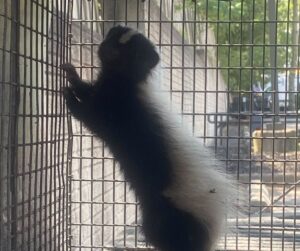 Skunks are a common nuisance animal that can douse you and your pets in their overwhelmingly awful scent, which is very difficult to get rid of. Skunks are also known to rip up lawns to search for grubs to eat, and they will knock over your trash cans and get into your garage to search for any pet food you might’ve left out. Skunks can also dig out dens underneath your porch, deck, or inside your crawl space, and they will spray to mark their territory. Don’t try to remove skunks yourself, as they can bite and scratch, and they are common rabies vectors. Westchester Wildlife can help. We offer skunk trapping and removal services in Westchester, as well as skunk exclusions, skunk damage repair and wildlife barriers. Contact us today to get started with a FREE estimate at (914) 760-5713!
Skunks are a common nuisance animal that can douse you and your pets in their overwhelmingly awful scent, which is very difficult to get rid of. Skunks are also known to rip up lawns to search for grubs to eat, and they will knock over your trash cans and get into your garage to search for any pet food you might’ve left out. Skunks can also dig out dens underneath your porch, deck, or inside your crawl space, and they will spray to mark their territory. Don’t try to remove skunks yourself, as they can bite and scratch, and they are common rabies vectors. Westchester Wildlife can help. We offer skunk trapping and removal services in Westchester, as well as skunk exclusions, skunk damage repair and wildlife barriers. Contact us today to get started with a FREE estimate at (914) 760-5713!
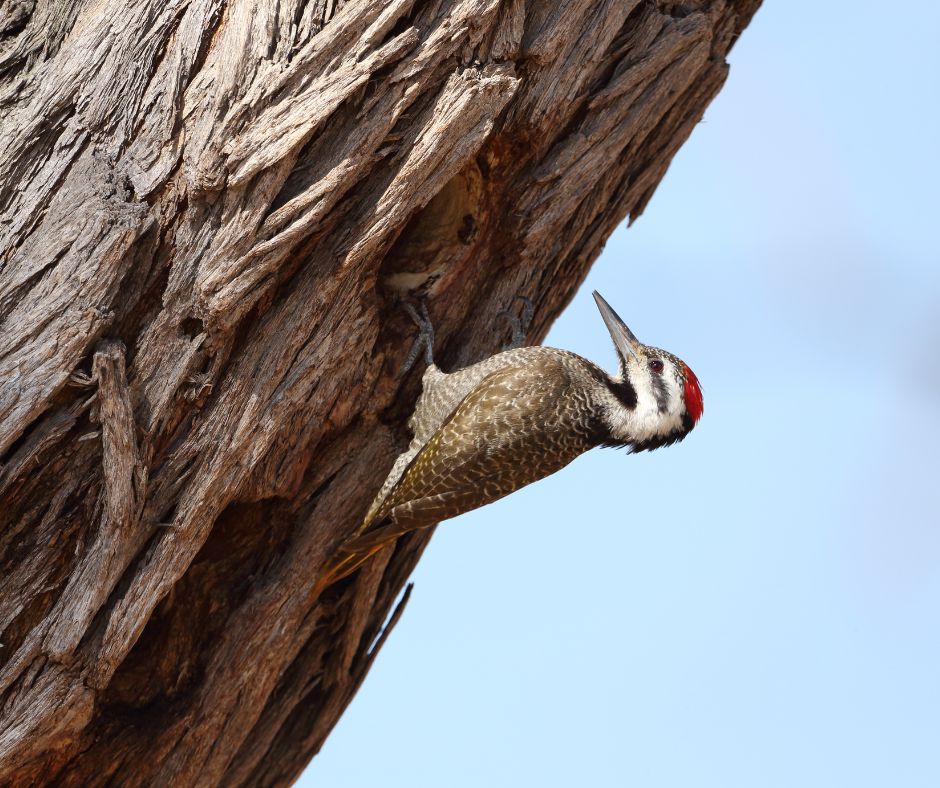 How To Keep Woodpeckers Out
How To Keep Woodpeckers Out
How To Keep Woodpeckers Out
Do you have woodpeckers damaging the side of your house in Westchester, NY? Woodpeckers are a common nuisance for homeowners, pecking and drilling away at siding, trees, wooden furniture, and even sometimes gutters and downspouts. Woodpeckers are difficult to get rid of, especially because they are protected under the Migratory Bird Treaty Act. Don’t worry, Westchester Wildlife can still help! We can provide you with exclusions and deterrents to keep woodpeckers from drilling at your home. We can also safely and humanely remove woodpeckers in accordance with laws and guidelines. Contact Westchester Wildlife to get started with a FREE estimate for woodpecker control and deterrent services in the NY/CT counties of Westchester, Putnam, Dutchess, Fairfield, and Litchfield at (800) 273-6673!
Types of Woodpeckers in CT and NY
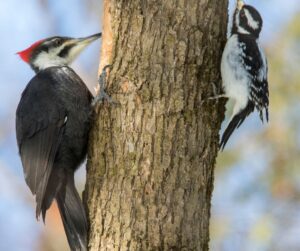 New York and Connecticut are home to many different types of woodpeckers, with these different species varying wildly in size and coloration. Some of the species you may encounter include:
New York and Connecticut are home to many different types of woodpeckers, with these different species varying wildly in size and coloration. Some of the species you may encounter include:
- Downy Woodpecker
- Hairy Woodpecker
- Yellow-bellied Sapsucker
- Northern Flicker
- Red-bellied Woodpecker
- Pileated Woodpecker
- Red-headed Woodpecker
No matter what type of woodpecker is damaging your property, Westchester Wildlife is here to help with exclusion and deterrent services.
Woodpecker Damage
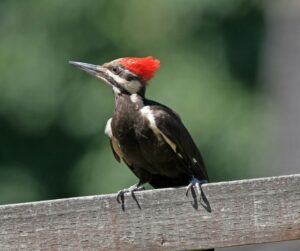 Woodpeckers feed on insects like carpenter ants and carpenter bees that spend their time inside wood, so they have evolved to have sharp, sturdy beaks with which to peck and drill rapidly at trees, creating cavities that allow them to snatch insects for a quick meal. Woodpeckers will also create cavities inside trees to make their nests. During the springtime, male woodpeckers will attract mates and mark their territory by pecking loudly at any hard surface they can find. Woodpeckers can actually be beneficial in the yard, as they are natural pest control agents that feed on insects. Problems with woodpeckers arise when they start drilling holes on the sides of houses, on decks, and on deck furniture in search of food. Additionally, woodpeckers may start pecking on gutters, downspouts, metal eaves, and your home’s siding during their mating season. Woodpecker damage doesn’t just cause unsightly damage to your property, it can also leave your home more vulnerable to water leaks and pest intrusions. Additionally, the actual drilling process can be extremely loud and annoying, and may even disrupt your sleep schedule.
Woodpeckers feed on insects like carpenter ants and carpenter bees that spend their time inside wood, so they have evolved to have sharp, sturdy beaks with which to peck and drill rapidly at trees, creating cavities that allow them to snatch insects for a quick meal. Woodpeckers will also create cavities inside trees to make their nests. During the springtime, male woodpeckers will attract mates and mark their territory by pecking loudly at any hard surface they can find. Woodpeckers can actually be beneficial in the yard, as they are natural pest control agents that feed on insects. Problems with woodpeckers arise when they start drilling holes on the sides of houses, on decks, and on deck furniture in search of food. Additionally, woodpeckers may start pecking on gutters, downspouts, metal eaves, and your home’s siding during their mating season. Woodpecker damage doesn’t just cause unsightly damage to your property, it can also leave your home more vulnerable to water leaks and pest intrusions. Additionally, the actual drilling process can be extremely loud and annoying, and may even disrupt your sleep schedule.
What Attracts Woodpeckers?
Woodpeckers are attracted to dead trees on your property, as they provide a perfect spot for them to build their nests. Woodpeckers love to eat wood destroying insects like termites, carpenter ants, carpenter bees, and wood boring beetles. If your home is infested with these pests, then woodpeckers will drill through your wooden structures to get these easy meals. If you have a bird feeder in your yard, woodpeckers will happily partake in any seeds or nuts inside. Woodpeckers are also attracted to the aluminum, tin, and other metals that might be on your roof, windows, flashing or gutters as they amplify their pecking sound, which is how woodpeckers communicate.
Woodpecker Deterrent
Woodpeckers are federally protected under the Migratory Bird Treaty Act, and must be handled with care. The best way to deal with a woodpecker problem is to deter them from your property. Bird spikes installed on high traffic areas will prevent them from landing, and installing bird netting will keep them out of your yard altogether. Scaring and hazing woodpeckers can also be effective, especially when two or more techniques are used at the same time. A good pest control program for your property can eliminate food sources for woodpeckers, which will cause them to move on from your home faster.
Woodpecker Control from Westchester Wildlife
Removal of woodpeckers from your property should be an absolute last resort, and you should never attempt to remove them yourself, as woodpeckers are federally protected. Always leave woodpecker removal to the experts at Westchester Wildlife. Our team can also seal off and fortify any holes that woodpeckers drilled into your home. Contact us to get started today with a FREE estimate at (800) 273-6673!
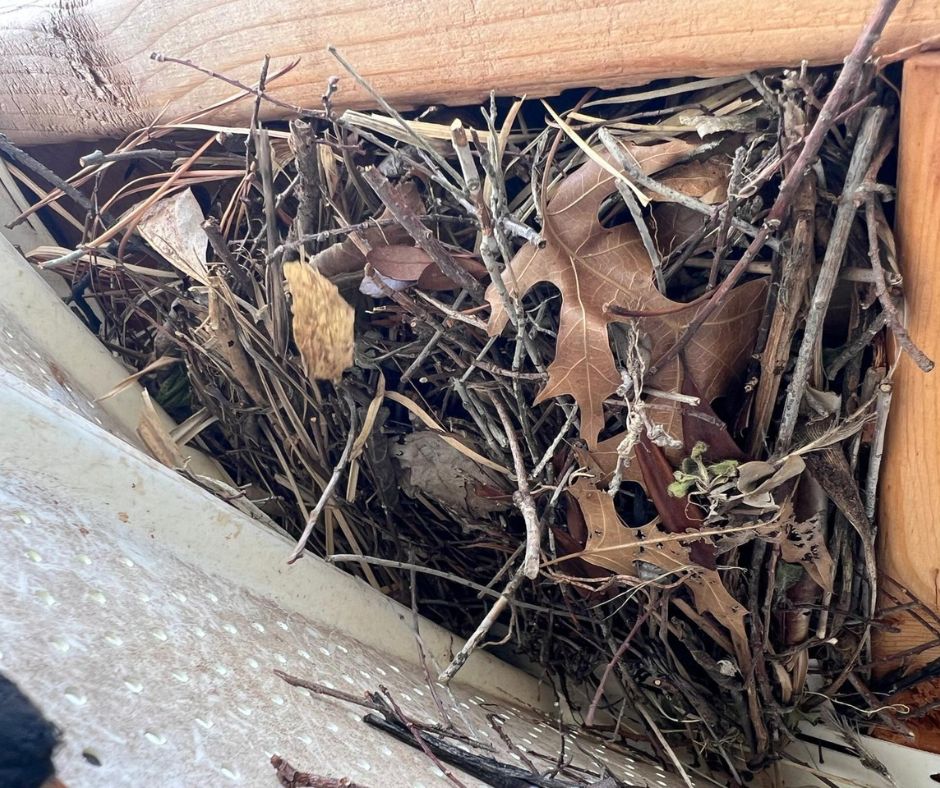 How To Prevent Wildlife from Entering Your Home as Temperatures Drop
How To Prevent Wildlife from Entering Your Home as Temperatures Drop
How To Prevent Wildlife from Entering Your Home as Temperatures Drop
Fall is here, and as the temperatures drop, nuisance pests and wildlife will be searching for ways to get inside your home in the Westchester, NY area. Raccoons, squirrels, birds, bats, mice, rats, and more will be searching for any potential entry point to your attic or crawl space that they can fit through, searching for a warm place to spend the winter, safe from the freezing temperatures. It’s important that your home is fortified against these critters for the fall, as once they get inside your home, they can spread diseases like rabies and cause catastrophic damage to your attic insulation. If you need wildlife removal or exclusion services in the Westchester area, contact the experts at Westchester Wildlife. Our team has years of experience dealing with nuisance wildlife, and you can rest assured that we will safely and humanely remove and exclude these critters from your property.
Wildlife in the Attic in the Fall
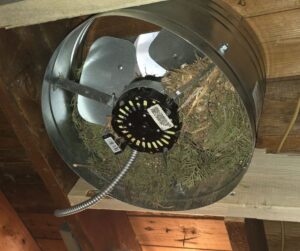 Your attic space is prime real estate for squirrels, raccoons, bats, birds, and more, especially as the temperatures cool down. Attic spaces provide safe, warm, secluded nesting areas that can protect against the harsh winter temperatures. Squirrels and raccoons will shred your insulation to create their nests, often soiling it in the process with urine and feces. Raccoons will dig latrines for their droppings, but squirrels will just go wherever, and the smell of their droppings can attract more squirrels to the attic. Raccoons in your attic can also tear through your HVAC ducts, and squirrels will gnaw on everything in sight, including the rubber covering around wires which can pose a fire risk. Squirrels also create a fire risk by bringing in outside nesting material, and birds nesting in your attic will do the same. Bats will roost from your rafters or gable vents, depositing large amounts of guano into your insulation over time. Bat guano contains the spores that cause the fungal lung infection histoplasmosis, and these spores can get stirred up in the air when the guano is removed, so always leave guano cleanup to the professionals. The best way to prevent animals from getting inside your attic in the fall is to carefully inspect your attic, and make sure all entry points are sealed and fortified to prevent anything from getting inside.
Your attic space is prime real estate for squirrels, raccoons, bats, birds, and more, especially as the temperatures cool down. Attic spaces provide safe, warm, secluded nesting areas that can protect against the harsh winter temperatures. Squirrels and raccoons will shred your insulation to create their nests, often soiling it in the process with urine and feces. Raccoons will dig latrines for their droppings, but squirrels will just go wherever, and the smell of their droppings can attract more squirrels to the attic. Raccoons in your attic can also tear through your HVAC ducts, and squirrels will gnaw on everything in sight, including the rubber covering around wires which can pose a fire risk. Squirrels also create a fire risk by bringing in outside nesting material, and birds nesting in your attic will do the same. Bats will roost from your rafters or gable vents, depositing large amounts of guano into your insulation over time. Bat guano contains the spores that cause the fungal lung infection histoplasmosis, and these spores can get stirred up in the air when the guano is removed, so always leave guano cleanup to the professionals. The best way to prevent animals from getting inside your attic in the fall is to carefully inspect your attic, and make sure all entry points are sealed and fortified to prevent anything from getting inside.
Dangers of Wildlife in your Chimney
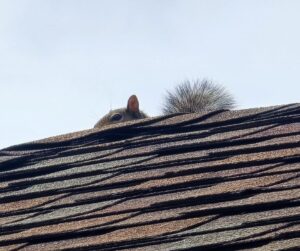 Your chimney also provides a good nesting place for raccoons, squirrels, bats, and birds. Similar to the attic space, your chimney provides a safe, warm, secluded place where these critters can hide from the cold. However, your chimney often provides direct access to your home, and these critters often carry diseases and parasites that they can transmit to you and your pets, including rabies, histoplasmosis, tularemia, leptospirosis, raccoon roundworm, fleas, ticks, bat bugs, and bird mites. Additionally, the nesting material that squirrels and birds bring into your attic can create a potential fire hazard, especially when the chimney is in use.
Your chimney also provides a good nesting place for raccoons, squirrels, bats, and birds. Similar to the attic space, your chimney provides a safe, warm, secluded place where these critters can hide from the cold. However, your chimney often provides direct access to your home, and these critters often carry diseases and parasites that they can transmit to you and your pets, including rabies, histoplasmosis, tularemia, leptospirosis, raccoon roundworm, fleas, ticks, bat bugs, and bird mites. Additionally, the nesting material that squirrels and birds bring into your attic can create a potential fire hazard, especially when the chimney is in use.
Rodent Activity in Fall: What Homeowners Need to Know
As the temperatures cool down in the fall, mice and rats will also be looking to invade your home in search of warmth and food. Make sure that you keep food in your pantry stored in sealed, airtight containers, as mice and rats will tear through soft plastic to eat your prepackaged food. Make sure you clean up crumbs or spills as soon as they happen, as these can also attract rodents, who will run across your food preparation services, leaving behind urine and droppings and spreading diseases like salmonella and hantavirus. When rats and mice get into your attic, they will chew through the rubber covering around wires, which can cause a house fire. Mice will also tunnel through your insulation, severely reducing its ability to resist heat. Mice and rats breed extremely quickly, and an infestation can get out of hand fast. As soon as you notice signs of rodents in your home, contact the rodent control experts at Westchester Wildlife. We can get your rodent infestation under control and provide you with seal-outs to ensure they don’t come back.
Inspecting and Sealing Entry Points
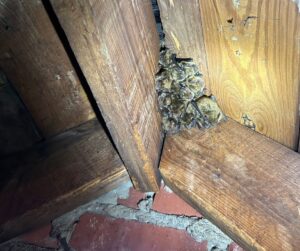 The best way to prevent raccoons, squirrels, birds, bats, mice, and rats from getting inside your home during the fall is to have a licensed wildlife removal company like Westchester Wildlife carefully inspect your home for potential entry points, then seal and fortify them. Squirrels and raccoons will search for tiny cracks and gaps inside your roof, soffit, fascia, or rake board, and then widen these holes with their claws and teeth to gain entry to the attic. Bats can enter through similar gaps, and bats can also enter through gable vents in your attic that aren’t properly sealed. Sealing off your chimney with a chimney cap will allow it to function as normal, but will also keep critters out. Entry points for rodents can be anywhere, so make sure your doors and windows are sealed and equipped with screens, and look for smaller places like where utility lines enter the home. Call Westchester Wildlife to get started with exclusion work for your home this fall at (914) 760-5713!
The best way to prevent raccoons, squirrels, birds, bats, mice, and rats from getting inside your home during the fall is to have a licensed wildlife removal company like Westchester Wildlife carefully inspect your home for potential entry points, then seal and fortify them. Squirrels and raccoons will search for tiny cracks and gaps inside your roof, soffit, fascia, or rake board, and then widen these holes with their claws and teeth to gain entry to the attic. Bats can enter through similar gaps, and bats can also enter through gable vents in your attic that aren’t properly sealed. Sealing off your chimney with a chimney cap will allow it to function as normal, but will also keep critters out. Entry points for rodents can be anywhere, so make sure your doors and windows are sealed and equipped with screens, and look for smaller places like where utility lines enter the home. Call Westchester Wildlife to get started with exclusion work for your home this fall at (914) 760-5713!
Fall Yard Cleanup to Deter Wildlife
Habitat modification in your yard can also prevent critters from setting up shop in your home. Bat houses are small structures that provide a roosting place for bats other than your attic, and these structures can be easily placed on trees in your yard, attracting bats that might otherwise become a nuisance. Fall is the season of falling leaves, but letting these leaves accumulate in large piles on your lawn provides easy cover for lawn-killing pests like moles and voles, rodents like mice and rats, and predators like snakes. Make sure that leaves are regularly raked, bushes and overgrown plants are trimmed regularly, and the grass is cut short. Keeping your lawn tidy will make critters feel exposed and unsafe in your yard, keeping them from causing any damage to your property.
The Benefits of Wildlife-Proofing Your Home for Fall
As the falling leaves and cooler temperatures of autumn arrive, it’s important to make sure that you are taking measures to keep the wildlife out of your home. Critters like raccoons, squirrels, bats, birds, rats, mice, and more will break their way into your home through your attic, chimney, or crawl space, cause extensive damage to your roof, insulation, or property, spread diseases and parasites, and even create potential fire risks. The best way to keep animals out of your home is to make sure all potential entry points are sealed and fortified. That’s where Westchester Wildlife comes in. Our team can carefully inspect all areas of the property, locate potential entry points, and then perform exclusion work, ensuring that they can’t come back. We also offer wildlife trapping and removal services in Westchester, Putnam, Dutchess, and Fairfield. Contact our team to get started with a FREE estimate at (800) 273-6673.
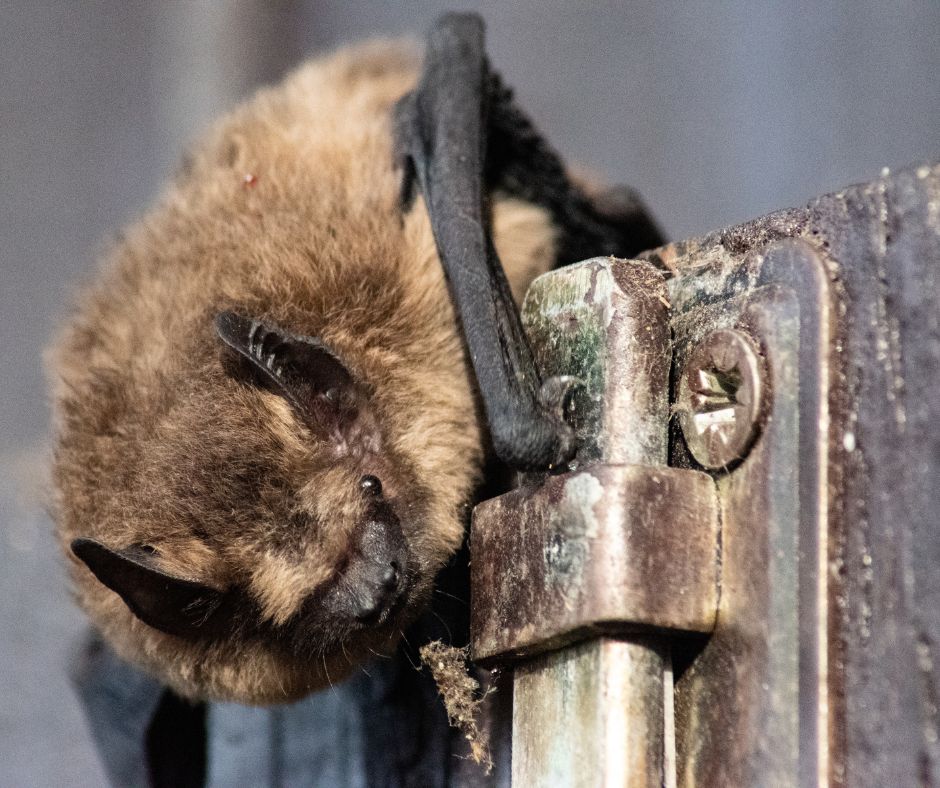 The Importance of Bat Exclusion
The Importance of Bat Exclusion
The Importance of Bat Exclusion
Do you have bats inside your attic in Westchester, NY? Bats are known to spread diseases like rabies, and they will soil your insulation with massive piles of guano, which can spread the respiratory disease histoplasmosis. Bats shouldn’t be living in your attic, but removing them can be tricky. While raccoons and squirrels can be easily trapped and removed at any time of the year, bats are a different story. Bats are federally protected animals that must be handled carefully and only removed under certain conditions. That’s why Jim Driesacker, owner of Westchester Wildlife, invented the Batcone and Pro-Cone, which are exclusionary one-way devices that allow bats to leave your attic but not re-enter. If you need bat removal and exclusion in the Westchester, NY area, contact the bat experts at Westchester Wildlife today at (800) 273-6673!
Why Are Bats Federally Protected?
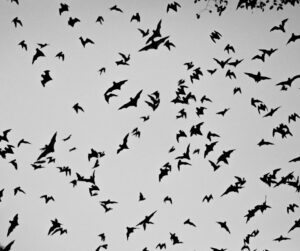 Bats are federally protected because of their ecological importance and endangered status. Bats are the original pest control technicians, as recent studies estimate that bats eat enough insect pests to save more than $3 BILLION dollars per year in pesticide costs and crop damage for American farmers. Bats can significantly reduce the population of harmful insects like mosquitoes in your yard. Bats are also expert pollinators and seed dispersers, and their continued presence is crucial to the growth of peaches, agave, bananas, and many other fruits. Unfortunately, bat populations are declining due to the presence of white-nose syndrome, which is a fungal disease that can easily spread through bat and human activity, killing off entire colonies of bats in the process. Because of this, bats are federally protected and must be handled with care. Unfortunately, conflict between humans and bats may arise when bats make their way inside your attic.
Bats are federally protected because of their ecological importance and endangered status. Bats are the original pest control technicians, as recent studies estimate that bats eat enough insect pests to save more than $3 BILLION dollars per year in pesticide costs and crop damage for American farmers. Bats can significantly reduce the population of harmful insects like mosquitoes in your yard. Bats are also expert pollinators and seed dispersers, and their continued presence is crucial to the growth of peaches, agave, bananas, and many other fruits. Unfortunately, bat populations are declining due to the presence of white-nose syndrome, which is a fungal disease that can easily spread through bat and human activity, killing off entire colonies of bats in the process. Because of this, bats are federally protected and must be handled with care. Unfortunately, conflict between humans and bats may arise when bats make their way inside your attic.
Bats in the Attic Damage
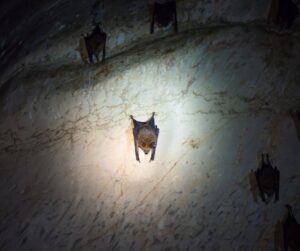 Your attic provides the perfect place for bats to roost, as it is dark, warm, and safe from predators and the elements. While bats in your attic can keep your pest population down by feeding in your yard at night, these animals can also spread several serious diseases and damage your insulation. Bats are known carriers of rabies, and if a bat gets inside the living areas of your home, it is crucial to capture the animal and test it for the rabies virus. Any skin-to-skin exposure with a bat must be treated as a potential rabies exposure. Bats will hang upside down in your attic and drop massive piles of guano, or bat droppings, inside your insulation. Bat guano not only soils the insulation and damages its ability to regulate heat, but it also contains the spores that cause the fungal lung infection histoplasmosis.
Your attic provides the perfect place for bats to roost, as it is dark, warm, and safe from predators and the elements. While bats in your attic can keep your pest population down by feeding in your yard at night, these animals can also spread several serious diseases and damage your insulation. Bats are known carriers of rabies, and if a bat gets inside the living areas of your home, it is crucial to capture the animal and test it for the rabies virus. Any skin-to-skin exposure with a bat must be treated as a potential rabies exposure. Bats will hang upside down in your attic and drop massive piles of guano, or bat droppings, inside your insulation. Bat guano not only soils the insulation and damages its ability to regulate heat, but it also contains the spores that cause the fungal lung infection histoplasmosis.
Batcone and Pro-Cone
The Batcone and Pro-Cone are one-way devices that allow bats to leave the attic, but do not provide a surface that the bats can land on and climb up, which prevents them from getting back inside the attic. Jim Driesacker, owner of Westchester Wildlife, invented the Batcone and Pro-cone after working in the wildlife removal industry in the rural and suburban areas of New York and Connecticut. Bat infestations were common, and an exclusion device was needed to assist in the increasing demands of bat removal services from both residential and commercial structures. Batcone and Pro-cone products are endorsed by the Organization for Bat Conservation and Bat Conservation International. Batcones and Pro-cones are crucial for bat exclusion as they allow the bat to leave on its own terms and find a new nest that’s not in your attic, which helps keep the bat population in Westchester healthy and thriving. If you need bat removal and exclusion, trust the bat experts at Westchester Wildlife.
Best Bat Removal Service in Westchester, NY
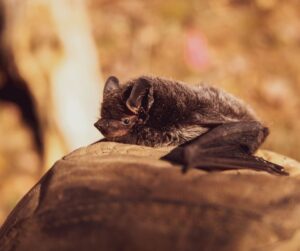 Bats are a federally protected animal that is very beneficial for the environment, as they eat thousands of insect pests per night, protect crops from pests, pollinate for crucial plants, and disperse fruit seeds. Bats must be handled with care, and the best way to deal with a bat infestation in your attic is to contact the bat experts at Westchester Wildlife for safe, humane bat removal and exclusion services. We will utilize the Batcone and Pro-cone products to safely exclude bats, then after the entire population is gone, we can seal off the property, ensuring that bats stay outside where they belong. If you need bat removal services in Westchester County, contact our team today to get started with a FREE estimate at (800) 273-6673!
Bats are a federally protected animal that is very beneficial for the environment, as they eat thousands of insect pests per night, protect crops from pests, pollinate for crucial plants, and disperse fruit seeds. Bats must be handled with care, and the best way to deal with a bat infestation in your attic is to contact the bat experts at Westchester Wildlife for safe, humane bat removal and exclusion services. We will utilize the Batcone and Pro-cone products to safely exclude bats, then after the entire population is gone, we can seal off the property, ensuring that bats stay outside where they belong. If you need bat removal services in Westchester County, contact our team today to get started with a FREE estimate at (800) 273-6673!
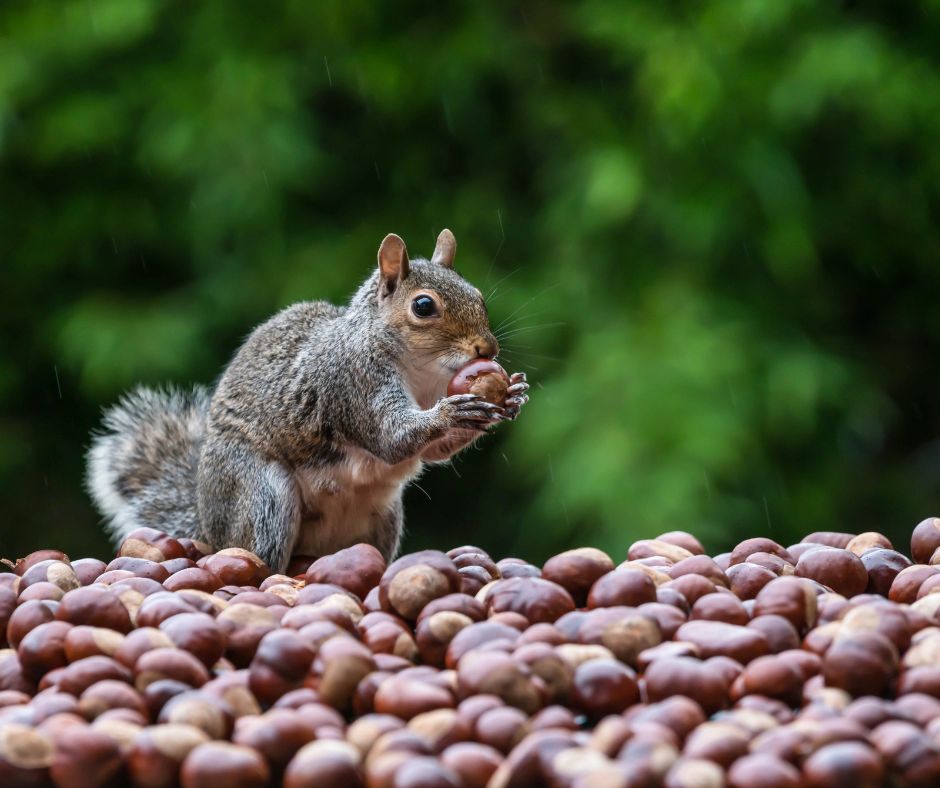 How Do Squirrels Prepare For Winter?
How Do Squirrels Prepare For Winter?
How Do Squirrels Prepare For Winter?
Labor Day has come and passed, and summer will soon be on its way out. As we get ready for the holidays and the colder weather of fall and winter, you might notice squirrels are more commonly out and about, scurrying across treetops and scavenging for food. Squirrels spend most of the summer and especially fall building up large storages of food that can satisfy them through the winter. Squirrels will also eat as much as possible, packing on fat stores that can keep them warm and sustain them when food is low. Additionally, squirrels will begin building nests inside trees or attic spaces to provide shelter for them and their young during the colder months.
If you have squirrels causing damage on your property, don’t panic. Squirrel populations can be easily handled through habitat modification and a good trapping and exclusion program. Westchester Wildlife can help, we offer the best squirrel trapping, removal, and exclusion services in Westchester County. Don’t get stuck with squirrel roommates this winter, contact our team to get started today with a FREE estimate at (914) 760-5713!
What Do Squirrels Eat?
During the fall, squirrels will be constantly on the move, searching for food they can consume to pack on the pounds or to store in a cache for the winter. Squirrels are major omnivores, and will eat pretty much anything that they can get their paws on. The main staples of the squirrel’s diet are nuts, seeds, and fruits, which they will scavenge for from trees, gardens, and birdfeeders. You might find squirrels feeding on plant roots and mushrooms. Squirrels also enjoy human foods that are high in fat or sugar, like cheese or cereal. If you have pet food that you are leaving out overnight, squirrels will raid these bowls for the food inside. Squirrels will also go after unprotected bird eggs, as well as some insects, grubs, worms, and small lizards.
Squirrel Hoarding
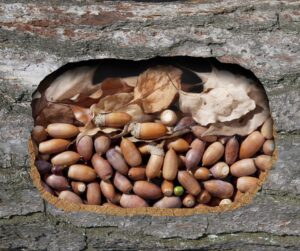 While squirrels will eat pretty much anything edible, they prioritize nuts and seeds above all else, as these can be stored inside their food caches for later use. Nuts and seeds can be eaten during the cold, dead, winter months, when food like plant roots, bird eggs, and insects are scarce. Squirrels store their food in caches, either in a scatter system or a larder system. Scatter systems involve squirrels digging numerous shallow pits, with a few nuts or seeds placed in each, and then over the winter months, digging them back up and eating them. Larder systems involve squirrels storing massive amounts of nuts and seeds in one location, like a tree cavity. If a squirrel has gotten comfortable enough in your attic, they might store these larder caches inside your attic space or even your wall voids. Discovering a large amount of nuts and seeds stored somewhere in your home is a surefire sign that squirrels are nesting on your property.
While squirrels will eat pretty much anything edible, they prioritize nuts and seeds above all else, as these can be stored inside their food caches for later use. Nuts and seeds can be eaten during the cold, dead, winter months, when food like plant roots, bird eggs, and insects are scarce. Squirrels store their food in caches, either in a scatter system or a larder system. Scatter systems involve squirrels digging numerous shallow pits, with a few nuts or seeds placed in each, and then over the winter months, digging them back up and eating them. Larder systems involve squirrels storing massive amounts of nuts and seeds in one location, like a tree cavity. If a squirrel has gotten comfortable enough in your attic, they might store these larder caches inside your attic space or even your wall voids. Discovering a large amount of nuts and seeds stored somewhere in your home is a surefire sign that squirrels are nesting on your property.
Where Do Squirrels Take Shelter for the Winter?
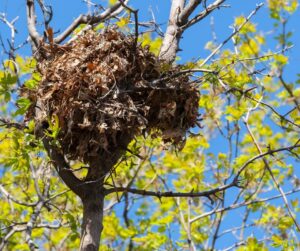 Squirrels stay active throughout the winter, continuing to dig up their food caches from the fall and search for any scarce food that they can find. However, during especially cold or snowy days, squirrels will stay inside their nests, sleeping and lowering their metabolism to conserve heat and energy. There are two main types of squirrel nests: dreys and cavity nests. Squirrel dreys are the large, scraggly clumps of dead leaves and twigs that you will see high up in large trees. Dreys are usually about 20 feet up, preferably in a tree that bears nuts, and located at the fork of two strong branches. While they look sharp and uncomfortable on the outside, the inside is usually made of soft moss or pine needles. Cavity nests are built inside a hollow tree or attic space, lined with leaves, moss, pine needles, straw, and more. Cavity nests provide squirrels with greater protection from harsh weather, heavy precipitation, and predators. Your home’s attic space provides the perfect spot for cavity nests, as the heat from your home and your soft, fluffy attic insulation provide them with a comfortable place to raise their young.
Squirrels stay active throughout the winter, continuing to dig up their food caches from the fall and search for any scarce food that they can find. However, during especially cold or snowy days, squirrels will stay inside their nests, sleeping and lowering their metabolism to conserve heat and energy. There are two main types of squirrel nests: dreys and cavity nests. Squirrel dreys are the large, scraggly clumps of dead leaves and twigs that you will see high up in large trees. Dreys are usually about 20 feet up, preferably in a tree that bears nuts, and located at the fork of two strong branches. While they look sharp and uncomfortable on the outside, the inside is usually made of soft moss or pine needles. Cavity nests are built inside a hollow tree or attic space, lined with leaves, moss, pine needles, straw, and more. Cavity nests provide squirrels with greater protection from harsh weather, heavy precipitation, and predators. Your home’s attic space provides the perfect spot for cavity nests, as the heat from your home and your soft, fluffy attic insulation provide them with a comfortable place to raise their young.
Habitat Modification for Squirrels
Squirrels can be a major nuisance when they decide to settle down on your property for the winter. Squirrels will gnaw and scratch at any cracks or gaps they can find in your roof, soffit, fascia board or rake board, and once they get inside your attic, they will rip up and soil your insulation. If you are starting to see a suspicious amount of squirrels on your property and you want to deter them from sticking around, then removing things from your yard that attract squirrels is a great start. Removing bird feeders, securing outdoor trash cans, taking in all pet food at night, and regularly removing nuts, seeds, and fruit that fall in your yard will help eliminate common food sources for squirrels. Having a licensed wildlife removal company like Westchester Wildlife come and inspect your home carefully for any entry points and then sealing these entry points can keep squirrels out.
Squirrel Trapping and Removal Services
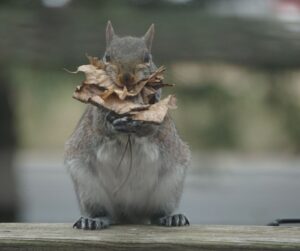 If squirrels have decided to pick your attic space as their winter home, contact the experts at Westchester Wildlife for the best squirrel trapping and removal services in Westchester County, NY. As the cooler weather of fall begins to set in, squirrels will feast on any food they can find to pack on fat, and they will start storing nuts and seeds around their territory in caches to revisit later, when food is scarce. Squirrels will nest inside tree branches, tree cavities, or, most preferably, your attic space, where they will rip up and soil your insulation. Squirrels are rodents, meaning they have prominent front teeth that never stop growing. In order to keep the length of their teeth manageable, they will gnaw on anything they can find. In your attic space, that can include wooden beams and the rubber covering around wires, which can react with the insulation and any outside nesting material and cause a house fire.
If squirrels have decided to pick your attic space as their winter home, contact the experts at Westchester Wildlife for the best squirrel trapping and removal services in Westchester County, NY. As the cooler weather of fall begins to set in, squirrels will feast on any food they can find to pack on fat, and they will start storing nuts and seeds around their territory in caches to revisit later, when food is scarce. Squirrels will nest inside tree branches, tree cavities, or, most preferably, your attic space, where they will rip up and soil your insulation. Squirrels are rodents, meaning they have prominent front teeth that never stop growing. In order to keep the length of their teeth manageable, they will gnaw on anything they can find. In your attic space, that can include wooden beams and the rubber covering around wires, which can react with the insulation and any outside nesting material and cause a house fire.
If you have squirrels inside your home, don’t panic. Our team of licensed wildlife control operators can safely trap and remove all the squirrels that have gotten inside your home. Afterward, we will repair the damage they created while getting inside, sealing off their entry points and preventing them from returning. Contact Westchester Wildlife today to get started with a FREE estimate at (914) 760-5713!
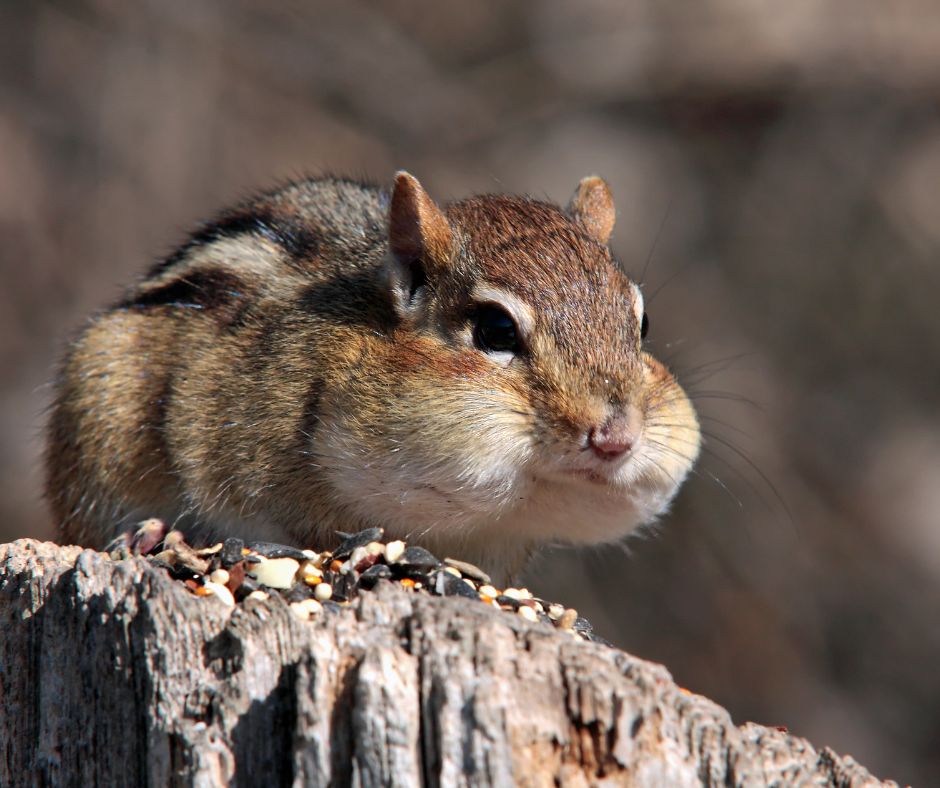 How To Get Rid of Chipmunks
How To Get Rid of Chipmunks
How To Get Rid of Chipmunks
Chipmunks are a very common nuisance wildlife in the Westchester, NY area. Chipmunks are small, reddish brown rodents with black and white vertical stripes on their backs. Chipmunks can be roughly 8-10 inches long, and weigh between 2 to 5 ounces. Chipmunks are known for wreaking havoc inside yards and gardens, as they eat flower bulbs and the roots, seeds, and seedlings of your vegetables. Chipmunks are also proficient diggers, and they will cause structural damage by digging underneath patios, porches, retaining walls, or even your home’s foundation.
Don’t worry, Westchester Wildlife can help. Our team of wildlife control operators can trap and remove chipmunk populations from your home, and we can also provide you with exclusions and seal outs to keep these pesky rodents from coming back. If you need chipmunk removal services, contact the experts at Westchester Wildlife today to get started at (914) 760-5713!
Chipmunk Garden Damage
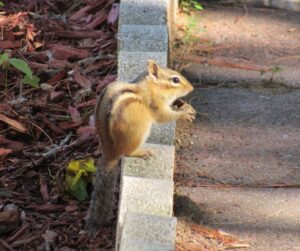 Chipmunks are omnivores that feed on seeds, nuts, berries, mushrooms, insects, worms, snails, bird eggs, frogs, fruits, and flowers. Whether you are growing flowers or vegetables, no garden is safe from the damage that chipmunks will inflict on it. Chipmunks will feast on the bulbs of flowers, and they will also happily eat roots, seeds, and seedlings of all your garden plants, which can disrupt their growth and lead to the death of the plant. If you are growing plants that bear fruits or nuts, chipmunks will steal and devour them. A group of chipmunks can decimate your garden seemingly overnight. Putting repellents on your plants might help, but never put repellents on plants made for human consumption.
Chipmunks are omnivores that feed on seeds, nuts, berries, mushrooms, insects, worms, snails, bird eggs, frogs, fruits, and flowers. Whether you are growing flowers or vegetables, no garden is safe from the damage that chipmunks will inflict on it. Chipmunks will feast on the bulbs of flowers, and they will also happily eat roots, seeds, and seedlings of all your garden plants, which can disrupt their growth and lead to the death of the plant. If you are growing plants that bear fruits or nuts, chipmunks will steal and devour them. A group of chipmunks can decimate your garden seemingly overnight. Putting repellents on your plants might help, but never put repellents on plants made for human consumption.
The best way to deal with a chipmunk damaging your garden is to contact Westchester Wildlife for chipmunk trapping and removal services at (914) 760-5713!
Chipmunk Burrow Damage
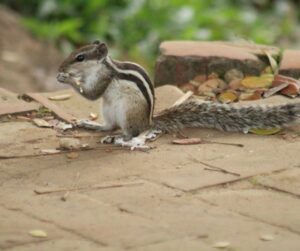 Garden plants aren’t the only thing at risk from chipmunks. Chipmunks excavate large burrows that can be 30 feet long and 3 feet deep. Chipmunk burrows have separate chambers for sleeping and storage of nuts and seeds, and the entrance holes to these burrows are around 2 inches in diameter. Chipmunks will dig their burrows underneath crucial structures on your property like patios, porch stairs and retaining walls, which can undermine the structural integrity and pose a major safety hazard. Chipmunk burrows can lead to these structures sinking into the ground, and they can also lead to people tripping in your yard.
Garden plants aren’t the only thing at risk from chipmunks. Chipmunks excavate large burrows that can be 30 feet long and 3 feet deep. Chipmunk burrows have separate chambers for sleeping and storage of nuts and seeds, and the entrance holes to these burrows are around 2 inches in diameter. Chipmunks will dig their burrows underneath crucial structures on your property like patios, porch stairs and retaining walls, which can undermine the structural integrity and pose a major safety hazard. Chipmunk burrows can lead to these structures sinking into the ground, and they can also lead to people tripping in your yard.
Chipmunks can even dig burrows underneath your home’s foundation, which can lead to the foundation cracking and settling, which can lead to water infiltration, leaks, and other problems inside the home.
Diseases Spread by Chipmunks
Chipmunks carry several diseases including
Chipmunks can also carry parasites like ticks and fleas, which spread their own diseases like Lyme Disease and Rocky Mountain Spotted Fever.
Chipmunk Exclusion and Habitat Modification
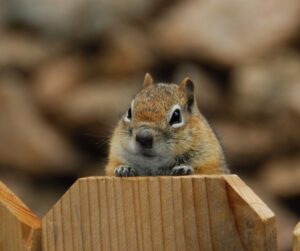 Chipmunk exclusion can help prevent these rodents from getting inside your garden or underneath your porch, patio, or foundation. Westchester Wildlife can provide you with mesh wildlife barriers/wildlife fencing around the perimeter of your garden, buried deep in the ground to prevent chipmunks from burrowing underneath it. Our team will also provide you with wildlife barriers around your patio, foundation, and porch to prevent chipmunk burrows from causing structural damage to your home.
Chipmunk exclusion can help prevent these rodents from getting inside your garden or underneath your porch, patio, or foundation. Westchester Wildlife can provide you with mesh wildlife barriers/wildlife fencing around the perimeter of your garden, buried deep in the ground to prevent chipmunks from burrowing underneath it. Our team will also provide you with wildlife barriers around your patio, foundation, and porch to prevent chipmunk burrows from causing structural damage to your home.
Habitat modification can also help prevent chipmunk issues. Remove wood piles, rock piles, and any debris from your foundation, as these provide chipmunks with cover from predators. Plants, tall grass, shrubs, and weeds around the perimeter of your foundation also make chipmunks feel safer in this area of your yard, and removing them will make them move on fairly quickly.
Chipmunk Trapping and Removal Near Me
Another way to deal with chipmunks on your property is to have them trapped and removed by licensed wildlife control operators like Westchester Wildlife. We have been dealing with chipmunks in the Westchester area for years, and we know their patterns and their behavior well. We can quickly and safely trap these troublesome rodents, and then remove them from your property, providing you with peace of mind. Chipmunks themselves are food for other nuisance wildlife like snakes, so removing chipmunks can help deter their predators too. If you need chipmunk trapping and removal services in the Westchester, NY area, contact the wildlife removal experts at Westchester Wildlife today at (914) 760-5713!
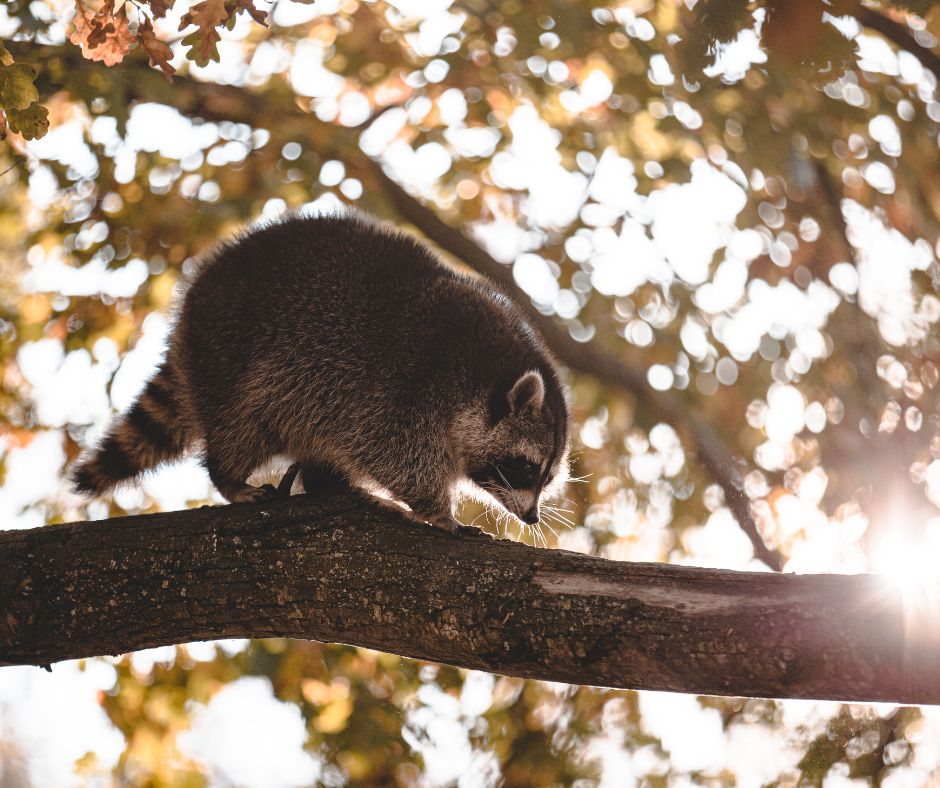 How To Identify Raccoon Infestations In Your Home
How To Identify Raccoon Infestations In Your Home
How To Identify Raccoon Infestations In Your Home
Do you have raccoons causing issues on your property? Raccoons will knock over and raid your trash cans, rip up your lawn, tear off roof shingles, get inside attics, and soil your insulation. Removing raccoons as soon as possible is imperative to limit the damage they can do to your property. Still, the first step of that is making sure it IS raccoons causing these issues and not another nuisance wildlife. Identifying the animal inside your attic or garage is crucial for safe and effective removal, so if you aren’t sure what critter has invaded your home, this blog can be your guide.
Physical Signs of Raccoons
 Raccoons are not graceful, and they will leave a path of destruction behind when they make their way inside your home. Raccoons love to nest inside attics, and they have no problem tearing through your soffit, eaves, and roof shingles to get inside. Squirrels and raccoons both claw and gnaw at tiny holes in your roof until they are wide enough to fit through, but a raccoon hole will be much larger than a squirrel hole.
Raccoons are not graceful, and they will leave a path of destruction behind when they make their way inside your home. Raccoons love to nest inside attics, and they have no problem tearing through your soffit, eaves, and roof shingles to get inside. Squirrels and raccoons both claw and gnaw at tiny holes in your roof until they are wide enough to fit through, but a raccoon hole will be much larger than a squirrel hole.
Raccoons are known for tipping over trash cans to feast on the garbage and food scraps left inside. If you go out to your garage or front yard and see the cans tipped over and garbage strewn about, this is a clear sign that you’ve been raided by a raccoon. Raccoons dig “latrines” which are communal defecating sites. When they dig latrines inside your attic insulation, you will be able to smell their pungent odor coming from inside your attic, which is another indicator of raccoons. However, these critters will also dig their latrines at the base of trees and underneath decks and porches. Raccoon feces are dark, tubular, and about 2-3 inches long. You can also identify raccoons by their tracks, which can be left in mud, dust, or after they step through water. Their front paws resemble small human hands with long claws, and their back paws are a similar shape, but with an elongated heel.
Raccoon Sounds
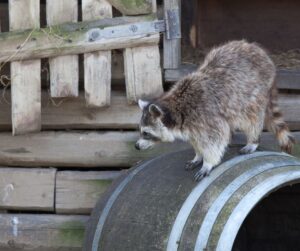 One of the easiest ways to identify a raccoon infestation inside your attic is to listen for the sounds they make. Birds and bats will make flapping and chirping sounds, while squirrels may make scampering or scratching sounds. Raccoons will loudly shuffle throughout your attic, creating loud stomping sounds that you might even mistake for human footsteps. Raccoons will also make scratching sounds, as well as ripping sounds as they rip up your attic insulation, and you might hear them knock over your trash can and throw the contents around.
One of the easiest ways to identify a raccoon infestation inside your attic is to listen for the sounds they make. Birds and bats will make flapping and chirping sounds, while squirrels may make scampering or scratching sounds. Raccoons will loudly shuffle throughout your attic, creating loud stomping sounds that you might even mistake for human footsteps. Raccoons will also make scratching sounds, as well as ripping sounds as they rip up your attic insulation, and you might hear them knock over your trash can and throw the contents around.
Raccoons also have a wide arsenal of vocal sounds. You might hear raccoons inside your attic chittering, growling, screaming, hissing, snarling, whimpering, or even purring. Raccoons can become aggressive when confronted, and they often carry rabies, so leave raccoon removal to the professionals.
Raccoon Removal in Westchester County
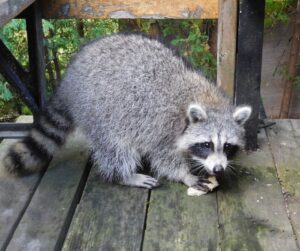 If you have identified a raccoon inside your garage, attic, or crawl space, don’t panic! Getting raccoons off your property can be quick and easy if you know who to call. Attempting to remove raccoons yourself isn’t a good idea, as these animals will often become extremely hostile, lashing out with their sharp teeth and claws, and they can also spread rabies through their bites. Raccoons also hide their babies deep within your attic insulation, and if you don’t find and remove all of them, the mother raccoon will rip the shingles off your roof to get back inside and retrieve her baby.
If you have identified a raccoon inside your garage, attic, or crawl space, don’t panic! Getting raccoons off your property can be quick and easy if you know who to call. Attempting to remove raccoons yourself isn’t a good idea, as these animals will often become extremely hostile, lashing out with their sharp teeth and claws, and they can also spread rabies through their bites. Raccoons also hide their babies deep within your attic insulation, and if you don’t find and remove all of them, the mother raccoon will rip the shingles off your roof to get back inside and retrieve her baby.
Local animal control also will not come remove raccoons that have set up shop in your attic, as they only handle domestic animals like cats and dogs, or wildlife that has gotten onto public property, like a road or park. A licensed wildlife removal company like Westchester Wildlife is your best bet for raccoon removal. We can safely and humanely trap and remove any raccoon that has set up shop in your attic, crawl space, or yard, and we will ensure that we remove all the babies, preventing the mother from returning. Contact us today to get started at (914) 760-5713!
Raccoon Deterrents and Prevention
An important aspect of raccoon removal is utilizing deterrents and preventative measures to keep the raccoons from coming back. To prevent raccoons, you should tightly secure your garbage can lids, and always bring bowls of pet food inside before bed. Getting rid of bird baths and other sources of water on your property can also encourage them not to stay.
Westchester Wildlife also offers raccoon deterrents. After removing the raccoon, we will seal and fortify all the raccoon’s entry points and any potential future entry points, preventing these critters from breaking their way inside your attic again.
Best Raccoon Trapping Near Me
You can easily identify raccoon infestations through visual cues like knocked-over trash cans, latrines, footprints, and large entry holes, or through sounds like stomping, scratching, growling, snarling, or whimpering. Once you’ve identified a raccoon infestation, contact the experts at Westchester Wildlife for raccoon trapping and removal services. We can ensure the raccoon and all raccoon babies are safely and humanely removed from your property. Westchester Wildlife also offers seal-outs and exclusions to deter raccoons from returning. Contact us today to get started with a FREE estimate at (914) 760-5713!
 Do Raccoons Hibernate? Understanding Their Winter Behavior and How They Survive the Cold
Do Raccoons Hibernate? Understanding Their Winter Behavior and How They Survive the Cold
 Raccoons do not hibernate during the winter, so they have several other body processes to help them survive the freezing temperatures and harsh conditions of winter. Raccoons, when faced with no other options, will enter a state of lowered activity called torpor, which is distinctly different from hibernation.
Raccoons do not hibernate during the winter, so they have several other body processes to help them survive the freezing temperatures and harsh conditions of winter. Raccoons, when faced with no other options, will enter a state of lowered activity called torpor, which is distinctly different from hibernation.  Raccoons are one of the most destructive nuisance wildlife in the Westchester area. Raccoons will exploit the tiniest cracks in your soffit, gable vents, ridge vents, or roof shingles. When a raccoon is nesting inside your attic, you might see damaged soffits, bent or destroyed vents, and missing shingles, signifying where the raccoons are entering and exiting from. Once inside, these critters will start ripping up and shredding your attic insulation, tearing through HVAC ducts, and scratching/gnawing on wooden beams and wires. Raccoons are mostly active at night, so if you are hearing scratching or loud shuffling sounds coming from your attic space, this is a sign that you have raccoons spending the winter in your home.
Raccoons are one of the most destructive nuisance wildlife in the Westchester area. Raccoons will exploit the tiniest cracks in your soffit, gable vents, ridge vents, or roof shingles. When a raccoon is nesting inside your attic, you might see damaged soffits, bent or destroyed vents, and missing shingles, signifying where the raccoons are entering and exiting from. Once inside, these critters will start ripping up and shredding your attic insulation, tearing through HVAC ducts, and scratching/gnawing on wooden beams and wires. Raccoons are mostly active at night, so if you are hearing scratching or loud shuffling sounds coming from your attic space, this is a sign that you have raccoons spending the winter in your home. 

 During the winter, pigeons that are well-adapted to urban and suburban areas will be searching for safe, warm places to begin building their nests. Unfortunately, your home’s attic provides the perfect harborage for these avian pests. Pigeons will nest inside your attic, your dryer vents, your gutters, and any other little pocket they can find in your home. Pigeon nests can be dangerous, as the dry twigs, dead leaves, dead grass and straw can lead to a fire hazard, especially if they are nesting inside your dryer vent. If their nests are inside your attic space, these birds can damage your shingles and your siding as they enter and exit the attic. Pigeons might also rip out your attic insulation to add to their nests, which can decrease the insulation’s ability to resist heat. However, the most significant damage caused by pigeons nesting in your home is through their corrosive droppings. Pigeon droppings are known to contain acidic uric acid, which can eat away at materials like wood, metal, shingles, and paint. Not only can this corrode the structures in your home, it can also lead to unsightly staining.
During the winter, pigeons that are well-adapted to urban and suburban areas will be searching for safe, warm places to begin building their nests. Unfortunately, your home’s attic provides the perfect harborage for these avian pests. Pigeons will nest inside your attic, your dryer vents, your gutters, and any other little pocket they can find in your home. Pigeon nests can be dangerous, as the dry twigs, dead leaves, dead grass and straw can lead to a fire hazard, especially if they are nesting inside your dryer vent. If their nests are inside your attic space, these birds can damage your shingles and your siding as they enter and exit the attic. Pigeons might also rip out your attic insulation to add to their nests, which can decrease the insulation’s ability to resist heat. However, the most significant damage caused by pigeons nesting in your home is through their corrosive droppings. Pigeon droppings are known to contain acidic uric acid, which can eat away at materials like wood, metal, shingles, and paint. Not only can this corrode the structures in your home, it can also lead to unsightly staining.  Pigeons can pose a risk to your home through their flammable nests and their corrosive droppings, and they can also pose a health hazard to you and your family through the various diseases and parasites they carry and spread. If you are hearing pigeon coos and flapping noises coming from your attic, or if you are seeing pigeon droppings and feathers around your property, it’s best to contact a licensed wildlife removal professional like Westchester Wildlife for pigeon removal services immediately. Our team of wildlife experts will carefully inspect your home for signs of pigeons, locating all the entry points and nesting. We will safely and humanely trap and remove all the pigeons on your property, and remediate any damage caused by these pest birds. Additionally, we also offer dead bird removal if you have a dead pigeon inside your home or yard. If you need pigeon removal services in the Westchester area, contact our team today to get on the schedule at
Pigeons can pose a risk to your home through their flammable nests and their corrosive droppings, and they can also pose a health hazard to you and your family through the various diseases and parasites they carry and spread. If you are hearing pigeon coos and flapping noises coming from your attic, or if you are seeing pigeon droppings and feathers around your property, it’s best to contact a licensed wildlife removal professional like Westchester Wildlife for pigeon removal services immediately. Our team of wildlife experts will carefully inspect your home for signs of pigeons, locating all the entry points and nesting. We will safely and humanely trap and remove all the pigeons on your property, and remediate any damage caused by these pest birds. Additionally, we also offer dead bird removal if you have a dead pigeon inside your home or yard. If you need pigeon removal services in the Westchester area, contact our team today to get on the schedule at 



 The biggest risk associated with skunks is the extremely foul-smelling spray they will unleash on whatever is posing a direct threat to them. Thankfully, skunks are not an aggressive animal, and will prefer to run away from a fight. Even if a skunk does spray, it gives plenty of warning signs. Skunks about to spray will adopt a wide stance, raise their tail in the air, and aggressively stomp their feet, so if you see a skunk displaying these behaviors, remove yourself from the situation immediately. Skunk sprays can be a major irritant, affecting the eyes, nose, and respiratory system. The odor is unbearable and can cause nausea, and it is very difficult to get rid of. It’s even more difficult to get rid of when the skunk sprays your dog, as the scent can get trapped in their fur.
The biggest risk associated with skunks is the extremely foul-smelling spray they will unleash on whatever is posing a direct threat to them. Thankfully, skunks are not an aggressive animal, and will prefer to run away from a fight. Even if a skunk does spray, it gives plenty of warning signs. Skunks about to spray will adopt a wide stance, raise their tail in the air, and aggressively stomp their feet, so if you see a skunk displaying these behaviors, remove yourself from the situation immediately. Skunk sprays can be a major irritant, affecting the eyes, nose, and respiratory system. The odor is unbearable and can cause nausea, and it is very difficult to get rid of. It’s even more difficult to get rid of when the skunk sprays your dog, as the scent can get trapped in their fur.  Never attempt to trap or remove skunks by yourself, as they can and will spray if they feel cornered, and they are also armed with sharp teeth and claws that they can lash out with, especially if they are protecting their babies. Skunks can spread rabies through their scratches and bites, so always leave skunk removal to the experts at Westchester Wildlife. Our team will safely and humanely trap and remove skunks, taking special care to remove the skunk babies with their mother. If you need skunk trapping and removal services in Westchester County, NY, Putnam County, NY, Dutchess County, NY, Fairfield County, CT or Litchfield County, CT, contact the experts at Westchester Wildlife today at (914) 760-5713!
Never attempt to trap or remove skunks by yourself, as they can and will spray if they feel cornered, and they are also armed with sharp teeth and claws that they can lash out with, especially if they are protecting their babies. Skunks can spread rabies through their scratches and bites, so always leave skunk removal to the experts at Westchester Wildlife. Our team will safely and humanely trap and remove skunks, taking special care to remove the skunk babies with their mother. If you need skunk trapping and removal services in Westchester County, NY, Putnam County, NY, Dutchess County, NY, Fairfield County, CT or Litchfield County, CT, contact the experts at Westchester Wildlife today at (914) 760-5713! Skunks are a common nuisance animal that can douse you and your pets in their overwhelmingly awful scent, which is very difficult to get rid of. Skunks are also known to rip up lawns to search for grubs to eat, and they will knock over your trash cans and get into your garage to search for any pet food you might’ve left out. Skunks can also dig out dens underneath your porch, deck, or inside your crawl space, and they will spray to mark their territory. Don’t try to remove skunks yourself, as they can bite and scratch, and they are common rabies vectors. Westchester Wildlife can help. We offer skunk trapping and removal services in Westchester, as well as skunk exclusions, skunk damage repair and wildlife barriers. Contact us today to get started with a FREE estimate at (914) 760-5713!
Skunks are a common nuisance animal that can douse you and your pets in their overwhelmingly awful scent, which is very difficult to get rid of. Skunks are also known to rip up lawns to search for grubs to eat, and they will knock over your trash cans and get into your garage to search for any pet food you might’ve left out. Skunks can also dig out dens underneath your porch, deck, or inside your crawl space, and they will spray to mark their territory. Don’t try to remove skunks yourself, as they can bite and scratch, and they are common rabies vectors. Westchester Wildlife can help. We offer skunk trapping and removal services in Westchester, as well as skunk exclusions, skunk damage repair and wildlife barriers. Contact us today to get started with a FREE estimate at (914) 760-5713!
 New York and Connecticut are home to many different types of
New York and Connecticut are home to many different types of  Woodpeckers feed on insects like carpenter ants and carpenter bees that spend their time inside wood, so they have evolved to have sharp, sturdy beaks with which to peck and drill rapidly at trees, creating cavities that allow them to snatch insects for a quick meal. Woodpeckers will also create cavities inside trees to make their nests. During the springtime, male woodpeckers will attract mates and mark their territory by pecking loudly at any hard surface they can find. Woodpeckers can actually be beneficial in the yard, as they are natural pest control agents that feed on insects. Problems with woodpeckers arise when they start drilling holes on the sides of houses, on decks, and on deck furniture in search of food. Additionally, woodpeckers may start pecking on gutters, downspouts, metal eaves, and your home’s siding during their mating season. Woodpecker damage doesn’t just cause unsightly damage to your property, it can also leave your home more vulnerable to water leaks and pest intrusions. Additionally, the actual drilling process can be extremely loud and annoying, and may even disrupt your sleep schedule.
Woodpeckers feed on insects like carpenter ants and carpenter bees that spend their time inside wood, so they have evolved to have sharp, sturdy beaks with which to peck and drill rapidly at trees, creating cavities that allow them to snatch insects for a quick meal. Woodpeckers will also create cavities inside trees to make their nests. During the springtime, male woodpeckers will attract mates and mark their territory by pecking loudly at any hard surface they can find. Woodpeckers can actually be beneficial in the yard, as they are natural pest control agents that feed on insects. Problems with woodpeckers arise when they start drilling holes on the sides of houses, on decks, and on deck furniture in search of food. Additionally, woodpeckers may start pecking on gutters, downspouts, metal eaves, and your home’s siding during their mating season. Woodpecker damage doesn’t just cause unsightly damage to your property, it can also leave your home more vulnerable to water leaks and pest intrusions. Additionally, the actual drilling process can be extremely loud and annoying, and may even disrupt your sleep schedule. 
 Your attic space is prime real estate for squirrels, raccoons, bats, birds, and more, especially as the temperatures cool down. Attic spaces provide safe, warm, secluded nesting areas that can protect against the harsh winter temperatures. Squirrels and raccoons will shred your insulation to create their nests, often soiling it in the process with urine and feces. Raccoons will dig latrines for their droppings, but squirrels will just go wherever, and the smell of their droppings can attract more squirrels to the attic. Raccoons in your attic can also tear through your HVAC ducts, and squirrels will gnaw on everything in sight, including the rubber covering around wires which can pose a fire risk. Squirrels also create a fire risk by bringing in outside nesting material, and birds nesting in your attic will do the same. Bats will roost from your rafters or gable vents, depositing large amounts of guano into your insulation over time. Bat guano contains the spores that cause the fungal lung infection
Your attic space is prime real estate for squirrels, raccoons, bats, birds, and more, especially as the temperatures cool down. Attic spaces provide safe, warm, secluded nesting areas that can protect against the harsh winter temperatures. Squirrels and raccoons will shred your insulation to create their nests, often soiling it in the process with urine and feces. Raccoons will dig latrines for their droppings, but squirrels will just go wherever, and the smell of their droppings can attract more squirrels to the attic. Raccoons in your attic can also tear through your HVAC ducts, and squirrels will gnaw on everything in sight, including the rubber covering around wires which can pose a fire risk. Squirrels also create a fire risk by bringing in outside nesting material, and birds nesting in your attic will do the same. Bats will roost from your rafters or gable vents, depositing large amounts of guano into your insulation over time. Bat guano contains the spores that cause the fungal lung infection  Your chimney also provides a good nesting place for raccoons, squirrels, bats, and birds. Similar to the attic space, your chimney provides a safe, warm, secluded place where these critters can hide from the cold. However, your chimney often provides direct access to your home, and these critters often carry diseases and parasites that they can transmit to you and your pets, including rabies, histoplasmosis,
Your chimney also provides a good nesting place for raccoons, squirrels, bats, and birds. Similar to the attic space, your chimney provides a safe, warm, secluded place where these critters can hide from the cold. However, your chimney often provides direct access to your home, and these critters often carry diseases and parasites that they can transmit to you and your pets, including rabies, histoplasmosis,  The best way to prevent raccoons, squirrels, birds, bats, mice, and rats from getting inside your home during the fall is to have a licensed wildlife removal company like Westchester Wildlife carefully inspect your home for potential entry points, then seal and fortify them. Squirrels and raccoons will search for tiny cracks and gaps inside your roof, soffit, fascia, or rake board, and then widen these holes with their claws and teeth to gain entry to the attic. Bats can enter through similar gaps, and bats can also enter through gable vents in your attic that aren’t properly sealed. Sealing off your chimney with a chimney cap will allow it to function as normal, but will also keep critters out. Entry points for rodents can be anywhere, so make sure your doors and windows are sealed and equipped with screens, and look for smaller places like where utility lines enter the home. Call Westchester Wildlife to get started with exclusion work for your home this fall at
The best way to prevent raccoons, squirrels, birds, bats, mice, and rats from getting inside your home during the fall is to have a licensed wildlife removal company like Westchester Wildlife carefully inspect your home for potential entry points, then seal and fortify them. Squirrels and raccoons will search for tiny cracks and gaps inside your roof, soffit, fascia, or rake board, and then widen these holes with their claws and teeth to gain entry to the attic. Bats can enter through similar gaps, and bats can also enter through gable vents in your attic that aren’t properly sealed. Sealing off your chimney with a chimney cap will allow it to function as normal, but will also keep critters out. Entry points for rodents can be anywhere, so make sure your doors and windows are sealed and equipped with screens, and look for smaller places like where utility lines enter the home. Call Westchester Wildlife to get started with exclusion work for your home this fall at 
 Bats are federally protected because of their ecological importance and endangered status. Bats are the original pest control technicians, as recent studies estimate that bats eat enough insect pests to save more than $3 BILLION dollars per year in pesticide costs and crop damage for American farmers. Bats can significantly reduce the population of harmful insects like mosquitoes in your yard. Bats are also expert pollinators and seed dispersers, and their continued presence is crucial to the growth of peaches, agave, bananas, and many other fruits. Unfortunately, bat populations are declining due to the presence of
Bats are federally protected because of their ecological importance and endangered status. Bats are the original pest control technicians, as recent studies estimate that bats eat enough insect pests to save more than $3 BILLION dollars per year in pesticide costs and crop damage for American farmers. Bats can significantly reduce the population of harmful insects like mosquitoes in your yard. Bats are also expert pollinators and seed dispersers, and their continued presence is crucial to the growth of peaches, agave, bananas, and many other fruits. Unfortunately, bat populations are declining due to the presence of  Your attic provides the perfect place for bats to roost, as it is dark, warm, and safe from predators and the elements. While bats in your attic can keep your pest population down by feeding in your yard at night, these animals can also spread several serious diseases and damage your insulation. Bats are known carriers of
Your attic provides the perfect place for bats to roost, as it is dark, warm, and safe from predators and the elements. While bats in your attic can keep your pest population down by feeding in your yard at night, these animals can also spread several serious diseases and damage your insulation. Bats are known carriers of  Bats are a federally protected animal that is very beneficial for the environment, as they eat thousands of insect pests per night, protect crops from pests, pollinate for crucial plants, and disperse fruit seeds. Bats must be handled with care, and the best way to deal with a bat infestation in your attic is to contact the bat experts at Westchester Wildlife for safe, humane bat removal and exclusion services. We will utilize the Batcone and Pro-cone products to safely exclude bats, then after the entire population is gone, we can seal off the property, ensuring that bats stay outside where they belong. If you need bat removal services in Westchester County, contact our team today to get started with a FREE estimate at
Bats are a federally protected animal that is very beneficial for the environment, as they eat thousands of insect pests per night, protect crops from pests, pollinate for crucial plants, and disperse fruit seeds. Bats must be handled with care, and the best way to deal with a bat infestation in your attic is to contact the bat experts at Westchester Wildlife for safe, humane bat removal and exclusion services. We will utilize the Batcone and Pro-cone products to safely exclude bats, then after the entire population is gone, we can seal off the property, ensuring that bats stay outside where they belong. If you need bat removal services in Westchester County, contact our team today to get started with a FREE estimate at 
 While squirrels will eat pretty much anything edible, they prioritize nuts and seeds above all else, as these can be stored inside their food caches for later use. Nuts and seeds can be eaten during the cold, dead, winter months, when food like plant roots, bird eggs, and insects are scarce. Squirrels store their food in caches, either in a scatter system or a larder system. Scatter systems involve squirrels digging numerous shallow pits, with a few nuts or seeds placed in each, and then over the winter months, digging them back up and eating them. Larder systems involve squirrels storing massive amounts of nuts and seeds in one location, like a tree cavity. If a squirrel has gotten comfortable enough in your attic, they might store these larder caches inside your attic space or even your wall voids. Discovering a large amount of nuts and seeds stored somewhere in your home is a surefire sign that squirrels are nesting on your property.
While squirrels will eat pretty much anything edible, they prioritize nuts and seeds above all else, as these can be stored inside their food caches for later use. Nuts and seeds can be eaten during the cold, dead, winter months, when food like plant roots, bird eggs, and insects are scarce. Squirrels store their food in caches, either in a scatter system or a larder system. Scatter systems involve squirrels digging numerous shallow pits, with a few nuts or seeds placed in each, and then over the winter months, digging them back up and eating them. Larder systems involve squirrels storing massive amounts of nuts and seeds in one location, like a tree cavity. If a squirrel has gotten comfortable enough in your attic, they might store these larder caches inside your attic space or even your wall voids. Discovering a large amount of nuts and seeds stored somewhere in your home is a surefire sign that squirrels are nesting on your property. Squirrels stay active throughout the winter, continuing to dig up their food caches from the fall and search for any scarce food that they can find. However, during especially cold or snowy days, squirrels will stay inside their nests, sleeping and lowering their metabolism to conserve heat and energy. There are two main types of squirrel nests: dreys and cavity nests. Squirrel dreys are the large, scraggly clumps of dead leaves and twigs that you will see high up in large trees. Dreys are usually about 20 feet up, preferably in a tree that bears nuts, and located at the fork of two strong branches. While they look sharp and uncomfortable on the outside, the inside is usually made of soft moss or pine needles. Cavity nests are built inside a hollow tree or attic space, lined with leaves, moss, pine needles, straw, and more. Cavity nests provide squirrels with greater protection from harsh weather, heavy precipitation, and predators. Your home’s attic space provides the perfect spot for cavity nests, as the heat from your home and your soft, fluffy attic insulation provide them with a comfortable place to raise their young.
Squirrels stay active throughout the winter, continuing to dig up their food caches from the fall and search for any scarce food that they can find. However, during especially cold or snowy days, squirrels will stay inside their nests, sleeping and lowering their metabolism to conserve heat and energy. There are two main types of squirrel nests: dreys and cavity nests. Squirrel dreys are the large, scraggly clumps of dead leaves and twigs that you will see high up in large trees. Dreys are usually about 20 feet up, preferably in a tree that bears nuts, and located at the fork of two strong branches. While they look sharp and uncomfortable on the outside, the inside is usually made of soft moss or pine needles. Cavity nests are built inside a hollow tree or attic space, lined with leaves, moss, pine needles, straw, and more. Cavity nests provide squirrels with greater protection from harsh weather, heavy precipitation, and predators. Your home’s attic space provides the perfect spot for cavity nests, as the heat from your home and your soft, fluffy attic insulation provide them with a comfortable place to raise their young. If squirrels have decided to pick your attic space as their winter home, contact the experts at Westchester Wildlife for the best squirrel trapping and removal services in Westchester County, NY. As the cooler weather of fall begins to set in, squirrels will feast on any food they can find to pack on fat, and they will start storing nuts and seeds around their territory in caches to revisit later, when food is scarce. Squirrels will nest inside tree branches, tree cavities, or, most preferably, your attic space, where they will rip up and soil your insulation. Squirrels are rodents, meaning they have prominent front teeth that never stop growing. In order to keep the length of their teeth manageable, they will gnaw on anything they can find. In your attic space, that can include wooden beams and the rubber covering around wires, which can react with the insulation and any outside nesting material and cause a house fire.
If squirrels have decided to pick your attic space as their winter home, contact the experts at Westchester Wildlife for the best squirrel trapping and removal services in Westchester County, NY. As the cooler weather of fall begins to set in, squirrels will feast on any food they can find to pack on fat, and they will start storing nuts and seeds around their territory in caches to revisit later, when food is scarce. Squirrels will nest inside tree branches, tree cavities, or, most preferably, your attic space, where they will rip up and soil your insulation. Squirrels are rodents, meaning they have prominent front teeth that never stop growing. In order to keep the length of their teeth manageable, they will gnaw on anything they can find. In your attic space, that can include wooden beams and the rubber covering around wires, which can react with the insulation and any outside nesting material and cause a house fire.
 Chipmunks are omnivores that feed on seeds, nuts, berries, mushrooms, insects, worms, snails, bird eggs, frogs, fruits, and flowers. Whether you are growing flowers or vegetables, no garden is safe from the damage that chipmunks will inflict on it. Chipmunks will feast on the bulbs of flowers, and they will also happily eat roots, seeds, and seedlings of all your garden plants, which can disrupt their growth and lead to the death of the plant. If you are growing plants that bear fruits or nuts, chipmunks will steal and devour them. A group of chipmunks can decimate your garden seemingly overnight. Putting repellents on your plants might help, but never put repellents on plants made for human consumption.
Chipmunks are omnivores that feed on seeds, nuts, berries, mushrooms, insects, worms, snails, bird eggs, frogs, fruits, and flowers. Whether you are growing flowers or vegetables, no garden is safe from the damage that chipmunks will inflict on it. Chipmunks will feast on the bulbs of flowers, and they will also happily eat roots, seeds, and seedlings of all your garden plants, which can disrupt their growth and lead to the death of the plant. If you are growing plants that bear fruits or nuts, chipmunks will steal and devour them. A group of chipmunks can decimate your garden seemingly overnight. Putting repellents on your plants might help, but never put repellents on plants made for human consumption.  Garden plants aren’t the only thing at risk from chipmunks. Chipmunks excavate large burrows that can be 30 feet long and 3 feet deep. Chipmunk burrows have separate chambers for sleeping and storage of nuts and seeds, and the entrance holes to these burrows are around 2 inches in diameter. Chipmunks will dig their burrows underneath crucial structures on your property like patios, porch stairs and retaining walls, which can undermine the structural integrity and pose a major safety hazard. Chipmunk burrows can lead to these structures sinking into the ground, and they can also lead to people tripping in your yard.
Garden plants aren’t the only thing at risk from chipmunks. Chipmunks excavate large burrows that can be 30 feet long and 3 feet deep. Chipmunk burrows have separate chambers for sleeping and storage of nuts and seeds, and the entrance holes to these burrows are around 2 inches in diameter. Chipmunks will dig their burrows underneath crucial structures on your property like patios, porch stairs and retaining walls, which can undermine the structural integrity and pose a major safety hazard. Chipmunk burrows can lead to these structures sinking into the ground, and they can also lead to people tripping in your yard. Chipmunk exclusion can help prevent these rodents from getting inside your garden or underneath your porch, patio, or foundation. Westchester Wildlife can provide you with mesh wildlife barriers/wildlife fencing around the perimeter of your garden, buried deep in the ground to prevent chipmunks from burrowing underneath it. Our team will also provide you with wildlife barriers around your patio, foundation, and porch to prevent chipmunk burrows from causing structural damage to your home.
Chipmunk exclusion can help prevent these rodents from getting inside your garden or underneath your porch, patio, or foundation. Westchester Wildlife can provide you with mesh wildlife barriers/wildlife fencing around the perimeter of your garden, buried deep in the ground to prevent chipmunks from burrowing underneath it. Our team will also provide you with wildlife barriers around your patio, foundation, and porch to prevent chipmunk burrows from causing structural damage to your home. 
 Raccoons are not graceful, and they will leave a path of destruction behind when they make their way inside your home. Raccoons love to nest inside attics, and they have no problem tearing through your soffit, eaves, and roof shingles to get inside.
Raccoons are not graceful, and they will leave a path of destruction behind when they make their way inside your home. Raccoons love to nest inside attics, and they have no problem tearing through your soffit, eaves, and roof shingles to get inside.  One of the easiest ways to identify a raccoon infestation inside your attic is to listen for the sounds they make.
One of the easiest ways to identify a raccoon infestation inside your attic is to listen for the sounds they make.  If you have identified a raccoon inside your garage, attic, or crawl space, don’t panic! Getting raccoons off your property can be quick and easy if you know who to call. Attempting to remove raccoons yourself isn’t a good idea, as these animals will often become extremely hostile, lashing out with their sharp teeth and claws, and they can also spread rabies through their bites. Raccoons also hide their babies deep within your attic insulation, and if you don’t find and remove all of them, the mother raccoon will rip the shingles off your roof to get back inside and retrieve her baby.
If you have identified a raccoon inside your garage, attic, or crawl space, don’t panic! Getting raccoons off your property can be quick and easy if you know who to call. Attempting to remove raccoons yourself isn’t a good idea, as these animals will often become extremely hostile, lashing out with their sharp teeth and claws, and they can also spread rabies through their bites. Raccoons also hide their babies deep within your attic insulation, and if you don’t find and remove all of them, the mother raccoon will rip the shingles off your roof to get back inside and retrieve her baby.